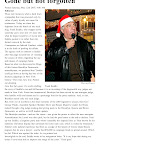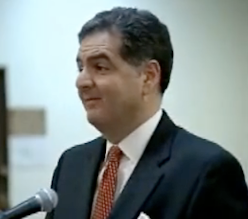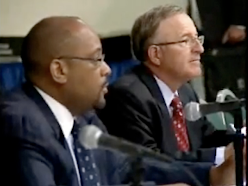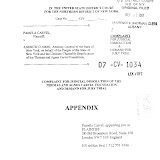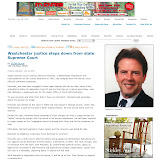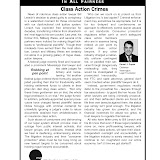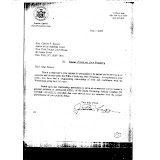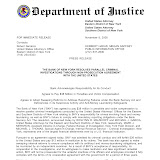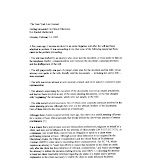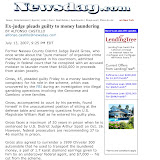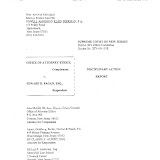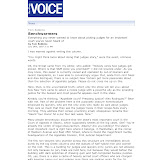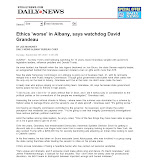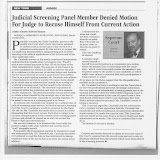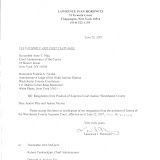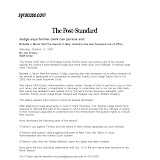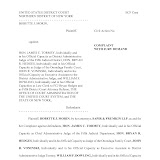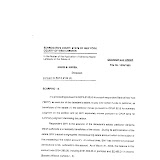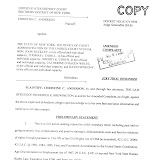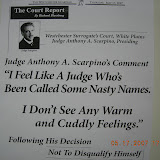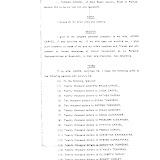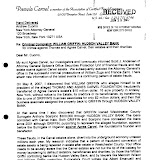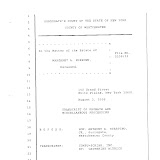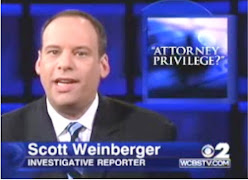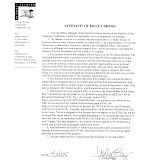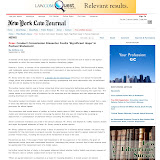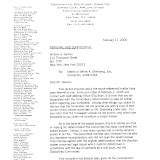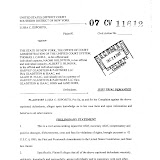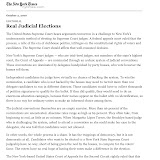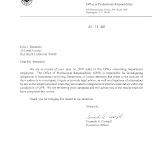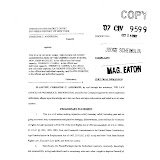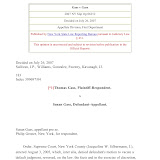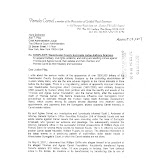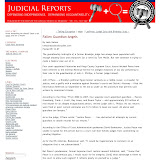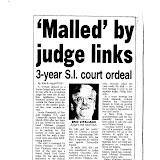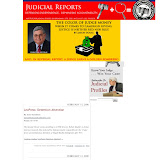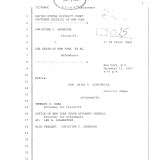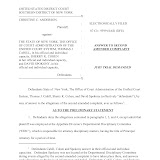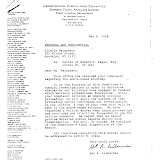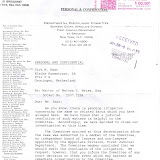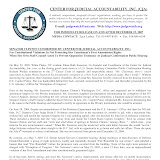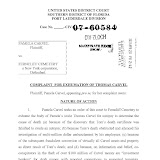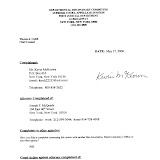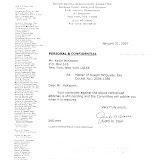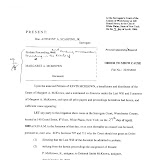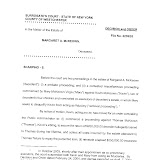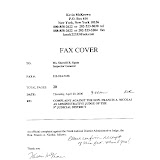Acting U.S. Attorney To Investigate Justice Department Dismissals
The Hartford Courant by EDMUND H. MAHONY - September 30, 2008
Acting U.S. Attorney Nora R. Dannehy became the third, senior federal prosecutor from Connecticut to land at the center of a high-profile, Washington political case when she was appointed Monday to look for criminal violations in the dismissal by the Justice Department of nine prosecutors in 2006. Dannehy, a career prosecutor known for winning convictions against Gov. John G. Rowland and state Treasurer Paul Silvester, was named by Attorney General Michael B. Mukasey to investigate "unanswered" questions about the Bush administration's dismissal of the U.S. attorneys, which was widely assailed as being politically motivated. Dannehy's appointment followed the release Monday of a report on an 18-month-long, internal Justice Department investigation that concluded top department officials "abdicated their responsibility" by failing to supervise subordinates who carried out the nine dismissals. What's more, the inquiry found "significant evidence" that partisan political factors played a role in some of the dismissals. The report, by the Justice Department offices of Inspector General and Professional Responsibility, said that former U.S. Attorney General Alberto Gonzales "bears primary responsibility" for what amounted to a series of botched removals. But it said that gaps remain in the investigation because of the refusal by key witnesses — among them former White House officials Karl Rove and Harriet Miers and U.S. Sen. Pete Domenici, R-N.M. — to submit to interviews. The authors of the report recommended that Mukasey name a special counsel to "ultimately determine whether the evidence demonstrates that any criminal offense was committed with regard to the removal of any U.S. Attorney, or with regard to the testimony of any witness related to the U.S. Attorney removals."
"Alberto Gonzalez is in trouble," said Connecticut defense attorney Hugh Keefe, who traded blows with Dannehy while representing Rowland co-chief of staff Peter N. Ellef Sr. in the corruption prosecution that led to the imprisonment of both Ellef and Rowland. "She is analytical and she is thorough, and if she suspects wrongdoing she will not let it go." Dannehy's grueling work schedule, her success at supervising long and complex investigations and her reputation for unstinting pursuit of what at times can seem to be tenuous evidence of criminal conduct are traits regularly volunteered by colleagues and attorneys on the defense side of her cases. But she just as frequently is applauded for forthrightness. Members of the relatively small group of defense attorneys who have done battle with her in high-profile Connecticut criminal trials have said that she means what she says and does what she promises — behavior that often falls by the wayside in pricey legal fights.
An Exodus Of Talent
Dannehy's appointment marks the most recent in what has become a series of high-level migrations to Washington from the U.S. attorney's office in New Haven. In April 2007, Gonzalez named former Connecticut U.S. Attorney Kevin O'Connor to be his chief of staff, just as Gonzales' job was beginning to unravel over political fallout from the dismissal of the U.S. attorneys. In November 2007, President Bush nominated O'Connor to be associate attorney general, the No. 3 position at the Justice Department. The U.S. Senate confirmed the nomination.
In January, Deputy U.S. Attorney John Durham — a veteran mob-buster, public corruption prosecutor and Dannehy mentor — was appointed to lead the Justice Department's investigation of the destruction of CIA videotapes documenting the interrogation of al-Qaida terror suspects. Durham's temporary transfer to Washington, which is ongoing, followed his long-term assignment to Boston, where he was assigned to investigate law enforcement corruption. One of Durham's Boston targets, former FBI Agent John Connolly, is on trial for murder in Miami, where he is accused of leaking information that compelled gangsters to kill a potential witness. Dannehy's assignment to Washington could give her more time with her husband, Leonard Boyle, another former Connecticut federal prosecutor who has been commuting between Connecticut and his job as director of the FBI Terrorist Screening Center's 350 employees.
The 5-year-old center operates a watch list of suspected terrorists. At times Monday, news of Dannehy's appointment seemed to submerge amid talk in legal circles of the continuing — if mostly temporary — exodus of federal prosecutorial talent. "It's really quite amazing," said defense attorney Hubert Santos, who represents Hartford Mayor Eddie Perez, now embroiled in a corruption investigation. "Durham and Dannehy have the two major criminal investigations in the country." Said Carl Tobias, who is on the faculty of the University of Richmond School of Law in Virginia, "It is somewhat curious that three attorneys for these critical positions all come from the same Connecticut U.S. attorney's office. She seems like a highly qualified career prosecutor who will carefully lead this investigation." Connecticut Attorney General Richard Blumenthal, whose office has at times bumped uncomfortably against Dannehy in political corruption cases, called her "a superb choice to conduct this much-needed, indeed, long-overdue investigation."
Formidable Opponent
Characteristically, Dannehy, 47, would not discuss her appointment and instructed her office not to do so. She has tried mightily throughout her career to avoid the limelight, even as that task has become more difficult with her involvement in high-profile political corruption cases. She became acting U.S. attorney following O'Connor's appointment as associate attorney general. Dannehy's acting appointment is expected to remain in force until the White House and Congress agree on a replacement for O'Connor.
A Justice Department spokesman in New Haven said that Dannehy is expected to begin the Washington investigation almost immediatelyand will divide her time between responsibilities in Washington and New Haven. Dannehy, an almost compulsive runner, is a formidable legal competitor. In one of her more memorable prosecutions, she emerged victorious after a three-year legal fight with top members of the Boston defense bar in the prosecution of a financier charged with bribery in the Silvester case. The Boston lawyers tried repeatedly to have her disqualified. She threatened to indict one of them for obstruction of justice. All but three of the state's federal judges removed themselves from the case over potential conflicts. Another withdrew in frustration. In the end, financier Frederick McCarthy was fined $40,000 and imprisoned. His company, Triumph Capital, was fined $4 million and driven out of business.
MLK said: "Injustice Anywhere is a Threat to Justice Everywhere"
End Corruption in the Courts!
Court employee, judge or citizen - Report Corruption in any Court Today !! As of June 15, 2016, we've received over 142,500 tips...KEEP THEM COMING !! Email: CorruptCourts@gmail.com
Most Read Stories
- Tembeckjian's Corrupt Judicial 'Ethics' Commission Out of Control
- As NY Judges' Pay Fiasco Grows, Judicial 'Ethics' Chief Enjoys Public-Paid Perks
- New York Judges Disgraced Again
- Wall Street Journal: When our Trusted Officials Lie
- Massive Attorney Conflict in Madoff Scam
- FBI Probes Threats on Federal Witnesses in New York Ethics Scandal
- Federal Judge: "But you destroyed the faith of the people in their government."
- Attorney Gives New Meaning to Oral Argument
- Wannabe Judge Attorney Writes About Ethical Dilemmas SHE Failed to Report
- 3 Judges Covered Crony's 9/11 Donation Fraud
- Former NY State Chief Court Clerk Sues Judges in Federal Court
- Concealing the Truth at the Attorney Ethics Committee
- NY Ethics Scandal Tied to International Espionage Scheme
- Westchester Surrogate's Court's Dastardly Deeds
Tuesday, September 30, 2008
Acting U.S. Attorney To Investigate Justice Department Dismissals
Monday, September 29, 2008
Outrage: Elderly Tax Lawyer Told He Can't Write Off Hookers
A state judge has ruled that a 77-year-old Bay Ridge tax lawyer must pay back taxes after wrongfully deducting more than $300,000 for prostitutes, porn, sex toys and erotic massages. After the verdict, the defendant William Halby told the Post, "I live a solitary life. I have no social life. I needed that release." So he dutifully documented each liaison in a notebook titled "Tax Journal," in case he ever got audited. Turns out that in 2002 alone, Halby deducted $111,364 for "therapeutic sex" and massages "to relieve osteoarthritis and enhance erectile function through frequent orgasm." He argued that the write-offs were necessary medical expenses. But because "significant portions" of his sex therapy was, you know, illegal, they can't be written off. The state auditor also argued that "in addition to being illegal in New York State, these expenses are not substantiated with receipts."
KINKY BID TO BE TAX XXX-EMPT
The New York Post by BRENDAN SCOTT and KEVIN FASICK - September 19, 2008
This was not the "happy ending" William Halby was looking for. The 77-year-old Brooklyn lawyer owes tens of thousands of dollars in back taxes for wrongly deducting more than $300,000 in prostitutes, porn, sex toys and erotic massages, a state tax judge ruled yesterday. The ruling came despite the meticulous efforts of Halby - a tax lawyer - to prove the deductions were reasonable medical expenses in his effort to fight depression and erectile dysfunction brought on by age. "I was depressed," Halby, who's divorced, semi-retired and living alone in a Bay Ridge apartment, told The Post yesterday. "I live a solitary life. I have no social life. I needed that release." Halby said he found his "sex surrogates" - preferably brunettes - through ads in The Village Voice and sometimes visited them several times a week. "Over the years, I've been with dozens of girls for full-body massage with . . . happy ending," he said. All told, Halby spent about $322,000 to satisfy his desires, according to court papers.
In 2002 alone, Halby deducted $111,364 for "therapeutic sex" and massages "to relieve osteoarthritis and enhance erectile function through frequent orgasm." He claimed another $2,173 on porn "to enhance sexual performance in lieu of taking Viagra." In 2003, his $101,930 in deductions included $162 for "sexual performance aids" such as lubes, condoms and nipple clamps, the court papers said. But the Department of Taxation and Finance roundly rejected the deductions, leaving the septuagenarian sex addict with a $24,271 state tax bill. "It must be noted that portions of [Halby's] 'sex therapy' were, in fact, sex for a fee, in violation of penal law," Administrative Law Judge Brian Friedman wrote. Halby, who faces similar action by the IRS, said he will appeal.
A former counsel for the Equitable Life Insurance Society of the United States, Halby represented himself through the proceedings. He meticulously recorded each liaison in a notebook titled "Tax Journal," including the cost and practitioners' first names. When auditors challenged the expenses, he produced books and articles demonstrating the health benefits of sex, including a 2001 New York Post article about the use of sex workers in Danish nursing homes. A state auditor dryly rejected the arguments. "Illegal treatments cannot be included in expenses," the auditor said. "In addition to being illegal in New York state, these expenses are not substantiated with receipts." Halby is "of counsel" with the Larchmont law firm McMillan, Constabile, Maker & Perone. Halby infrequently assists the firm with tax issues. A firm partner, Stewart McMillan, had not heard of Halby's tax troubles. "He seems like a nice man," McMillan said. "He's thought of as a good tax lawyer." brendan.scott@nypost.com
KINKY BID TO BE TAX XXX-EMPT
The New York Post by BRENDAN SCOTT and KEVIN FASICK - September 19, 2008
This was not the "happy ending" William Halby was looking for. The 77-year-old Brooklyn lawyer owes tens of thousands of dollars in back taxes for wrongly deducting more than $300,000 in prostitutes, porn, sex toys and erotic massages, a state tax judge ruled yesterday. The ruling came despite the meticulous efforts of Halby - a tax lawyer - to prove the deductions were reasonable medical expenses in his effort to fight depression and erectile dysfunction brought on by age. "I was depressed," Halby, who's divorced, semi-retired and living alone in a Bay Ridge apartment, told The Post yesterday. "I live a solitary life. I have no social life. I needed that release." Halby said he found his "sex surrogates" - preferably brunettes - through ads in The Village Voice and sometimes visited them several times a week. "Over the years, I've been with dozens of girls for full-body massage with . . . happy ending," he said. All told, Halby spent about $322,000 to satisfy his desires, according to court papers.
In 2002 alone, Halby deducted $111,364 for "therapeutic sex" and massages "to relieve osteoarthritis and enhance erectile function through frequent orgasm." He claimed another $2,173 on porn "to enhance sexual performance in lieu of taking Viagra." In 2003, his $101,930 in deductions included $162 for "sexual performance aids" such as lubes, condoms and nipple clamps, the court papers said. But the Department of Taxation and Finance roundly rejected the deductions, leaving the septuagenarian sex addict with a $24,271 state tax bill. "It must be noted that portions of [Halby's] 'sex therapy' were, in fact, sex for a fee, in violation of penal law," Administrative Law Judge Brian Friedman wrote. Halby, who faces similar action by the IRS, said he will appeal.
A former counsel for the Equitable Life Insurance Society of the United States, Halby represented himself through the proceedings. He meticulously recorded each liaison in a notebook titled "Tax Journal," including the cost and practitioners' first names. When auditors challenged the expenses, he produced books and articles demonstrating the health benefits of sex, including a 2001 New York Post article about the use of sex workers in Danish nursing homes. A state auditor dryly rejected the arguments. "Illegal treatments cannot be included in expenses," the auditor said. "In addition to being illegal in New York state, these expenses are not substantiated with receipts." Halby is "of counsel" with the Larchmont law firm McMillan, Constabile, Maker & Perone. Halby infrequently assists the firm with tax issues. A firm partner, Stewart McMillan, had not heard of Halby's tax troubles. "He seems like a nice man," McMillan said. "He's thought of as a good tax lawyer." brendan.scott@nypost.com
Sunday, September 28, 2008
Gov. Paterson Taking Charge: Vetos Court Power Scam
Paterson Rules Out Interlocutory Appeals In Jury Selection
The New York Law Journal by Joel Stashenko - September 29, 2008
ALBANY - A bill that would have established an interlocutory appeals process for disputed juror selections in civil trials was vetoed Friday by Governor David A. Paterson. The legislation (A11715/S8661) would have designated administrative judges in each judicial district to hear disputes over jury selection as they arose and created a right for parties to bring Article 78 proceedings if decisions by the administrative judges reflect a "deliberate failure" to adhere to selection procedures. The measure also called on the administrative board of the state courts, comprised of Chief Judge Judith S. Kaye and the four presiding Appellate Division justices, to establish new standardized selection procedures for Supreme and county courts throughout New York. The legislation has been pushed for years by the state Trial Lawyers Association, which contends that some judges and judicial hearing officers are flouting established procedures for choosing jurors. In opposition were the Fund for Modern Courts, the New York State Bar Association, New York City's Corporation Counsel and the state League of Women Voters. The New York City Bar Association's Committee on State Courts of Superior Jurisdiction also urged a veto of the bill. Opponents argued that the measure would have delayed the jury selection process in many cases, stretching already thin court resources, and undermined Chief Judge Kaye's campaign to make courts more juror-friendly.
In a veto message, Mr. Paterson explained that he had heard no "urgent or compelling justification" for signing a bill that makes several significant changes in court procedures. "The problem with this bill is that the proposed mechanisms contravene well-settled legal principles governing review of trial court determinations and would create logistical burdens that could unnecessarily delay trials and seriously inconvenience citizens performing their civic duties by appearing as jurors to hear civil cases," the veto message said. Mr. Paterson also noted that parties aggrieved by an error in the jury selection process can still seek to file a conventional appeal of an adverse judgment.
The bill had passed in the Assembly by a vote of 137-1 and in the Senate by 62-0. It was sponsored by the Judiciary Committee chairs in both chambers of the Legislature, Senator John A. DeFrancisco, R-Syracuse, and Assemblywoman Helene Weinstein, D-Brooklyn. Neither returned a call seeking comment Friday. The president of the Trial Lawyers Association, Nicholas Papain, said he was disappointed with the veto and would renew efforts to pass the measure during the next legislative session beginning in January. "We feel strongly that this bill was necessary to ensure that jury selection is conducted more fairly and that there are remedies when those in charge fail to follow the rules," Mr. Papain, a partner at Sullivan, Papain Block McGrath & Cannavo, said in an interview Friday. "A fair jury selection process is a cornerstone of our civil justice system."
The legislation was something of a compromise from an alternative measure (A8964B) that would have adopted the new procedures in a statute and not given any discretion to the administrative board (NYLJ, June 20). The state's chief administrative judge, Ann Pfau, lobbied against that bill, arguing that juror selection procedures were a matter for the court system to set and enforce. Court administrators say they can accomplish through court rule some of the reforms sought by the trial lawyers. Among other things, the group has complained that jury selection procedures can vary from court to court, sometimes from judge to judge, and should be standardized statewide in fairness to litigants and their attorneys. "The Trial Lawyers have brought to our attention some concerns that they have and we take their concerns very seriously," Judge Pfau said. "We look forward to working with them productively to address those concerns."
Mr. Papain said he would welcome changes by the administrative board to standardize jury selection procedures, but would not abandon the legislative approach. Legislation would be needed to create the appeals process for parties claiming that jury selection rules were being deliberately violated. "We feel very strongly that we must continue to pursue this avenue, that being legislation," Mr. Papain said. Lawpac, the Trial Lawyers Association's political action committee, gave Mr. Paterson's campaign committee a total of $54,900 in two donations on May 29. The donations were for $36,800 and $18,100.
Delays Feared
Appeals "have to [cause] more delay," said Victor A. Kovner, the chairman of the Committee for Modern Courts. "Unfortunately, there will be some lawyers who will try to take advantage of the system and play games with the process. We just can't have the jurors subjected to that." Modern Courts favors adoption of a uniform method of selecting civil juries throughout the state, Mr. Kovner said in an interview. "I think all of this can be accomplished by a court rule without delaying and stopping the jury selection process," he said.
New York City Corporation Counsel Michael A. Cardozo was also a critic of first A8964B and later of the bill that Mr. Paterson vetoed (NYLJ, Sept. 5). "I am very pleased that the governor has recognized that there is no need for this bill and that it could potentially cause substantial mischief in the selection of juries," Mr. Cardozo said in an interview. Typically, jury selection begins in between 400 and 500 civil cases a year in which Mr. Cardozo's attorneys defend New York City. The corporation counsel's office tried 122 cases to verdict last year.
"If everything was slowed down, we were going to have to find more lawyers to try those cases," Mr. Cardozo said. "Particularly at this time of budget crunch, I don't think we could have done it. It could have paralyzed the system." Mr. Papain said his 4,000-member group has received complaints about several aspects of unfair jury selection procedures, including instances where judges or judicial hearing officers have ignored rules calling for lawyers for the plaintiff and the defendant to alternate their challenges striking jurors. The situation is unfair where a lawyer is made to use challenges on jurors that the other side would have removed if the attorneys had alternated, Mr. Papain said. Other times, he said, lawyers have not been allowed to voir dire jurors on their attitudes toward damages in bifurcated trials, even though those same jurors would consider the question of compensation if they found the defendant liable for damages. Joel.Stashenko@incisivemedia.com
The New York Law Journal by Joel Stashenko - September 29, 2008
ALBANY - A bill that would have established an interlocutory appeals process for disputed juror selections in civil trials was vetoed Friday by Governor David A. Paterson. The legislation (A11715/S8661) would have designated administrative judges in each judicial district to hear disputes over jury selection as they arose and created a right for parties to bring Article 78 proceedings if decisions by the administrative judges reflect a "deliberate failure" to adhere to selection procedures. The measure also called on the administrative board of the state courts, comprised of Chief Judge Judith S. Kaye and the four presiding Appellate Division justices, to establish new standardized selection procedures for Supreme and county courts throughout New York. The legislation has been pushed for years by the state Trial Lawyers Association, which contends that some judges and judicial hearing officers are flouting established procedures for choosing jurors. In opposition were the Fund for Modern Courts, the New York State Bar Association, New York City's Corporation Counsel and the state League of Women Voters. The New York City Bar Association's Committee on State Courts of Superior Jurisdiction also urged a veto of the bill. Opponents argued that the measure would have delayed the jury selection process in many cases, stretching already thin court resources, and undermined Chief Judge Kaye's campaign to make courts more juror-friendly.
In a veto message, Mr. Paterson explained that he had heard no "urgent or compelling justification" for signing a bill that makes several significant changes in court procedures. "The problem with this bill is that the proposed mechanisms contravene well-settled legal principles governing review of trial court determinations and would create logistical burdens that could unnecessarily delay trials and seriously inconvenience citizens performing their civic duties by appearing as jurors to hear civil cases," the veto message said. Mr. Paterson also noted that parties aggrieved by an error in the jury selection process can still seek to file a conventional appeal of an adverse judgment.
The bill had passed in the Assembly by a vote of 137-1 and in the Senate by 62-0. It was sponsored by the Judiciary Committee chairs in both chambers of the Legislature, Senator John A. DeFrancisco, R-Syracuse, and Assemblywoman Helene Weinstein, D-Brooklyn. Neither returned a call seeking comment Friday. The president of the Trial Lawyers Association, Nicholas Papain, said he was disappointed with the veto and would renew efforts to pass the measure during the next legislative session beginning in January. "We feel strongly that this bill was necessary to ensure that jury selection is conducted more fairly and that there are remedies when those in charge fail to follow the rules," Mr. Papain, a partner at Sullivan, Papain Block McGrath & Cannavo, said in an interview Friday. "A fair jury selection process is a cornerstone of our civil justice system."
The legislation was something of a compromise from an alternative measure (A8964B) that would have adopted the new procedures in a statute and not given any discretion to the administrative board (NYLJ, June 20). The state's chief administrative judge, Ann Pfau, lobbied against that bill, arguing that juror selection procedures were a matter for the court system to set and enforce. Court administrators say they can accomplish through court rule some of the reforms sought by the trial lawyers. Among other things, the group has complained that jury selection procedures can vary from court to court, sometimes from judge to judge, and should be standardized statewide in fairness to litigants and their attorneys. "The Trial Lawyers have brought to our attention some concerns that they have and we take their concerns very seriously," Judge Pfau said. "We look forward to working with them productively to address those concerns."
Mr. Papain said he would welcome changes by the administrative board to standardize jury selection procedures, but would not abandon the legislative approach. Legislation would be needed to create the appeals process for parties claiming that jury selection rules were being deliberately violated. "We feel very strongly that we must continue to pursue this avenue, that being legislation," Mr. Papain said. Lawpac, the Trial Lawyers Association's political action committee, gave Mr. Paterson's campaign committee a total of $54,900 in two donations on May 29. The donations were for $36,800 and $18,100.
Delays Feared
Appeals "have to [cause] more delay," said Victor A. Kovner, the chairman of the Committee for Modern Courts. "Unfortunately, there will be some lawyers who will try to take advantage of the system and play games with the process. We just can't have the jurors subjected to that." Modern Courts favors adoption of a uniform method of selecting civil juries throughout the state, Mr. Kovner said in an interview. "I think all of this can be accomplished by a court rule without delaying and stopping the jury selection process," he said.
New York City Corporation Counsel Michael A. Cardozo was also a critic of first A8964B and later of the bill that Mr. Paterson vetoed (NYLJ, Sept. 5). "I am very pleased that the governor has recognized that there is no need for this bill and that it could potentially cause substantial mischief in the selection of juries," Mr. Cardozo said in an interview. Typically, jury selection begins in between 400 and 500 civil cases a year in which Mr. Cardozo's attorneys defend New York City. The corporation counsel's office tried 122 cases to verdict last year.
"If everything was slowed down, we were going to have to find more lawyers to try those cases," Mr. Cardozo said. "Particularly at this time of budget crunch, I don't think we could have done it. It could have paralyzed the system." Mr. Papain said his 4,000-member group has received complaints about several aspects of unfair jury selection procedures, including instances where judges or judicial hearing officers have ignored rules calling for lawyers for the plaintiff and the defendant to alternate their challenges striking jurors. The situation is unfair where a lawyer is made to use challenges on jurors that the other side would have removed if the attorneys had alternated, Mr. Papain said. Other times, he said, lawyers have not been allowed to voir dire jurors on their attitudes toward damages in bifurcated trials, even though those same jurors would consider the question of compensation if they found the defendant liable for damages. Joel.Stashenko@incisivemedia.com
Saturday, September 27, 2008
Judge Caught Driving Drunk in Drag Steers Way to Law Firm Gig
The National Law Journal by Sheri Qualters - September 25, 2008
BOSTON — Former U.S. District of Massachusetts federal bankruptcy judge Robert Somma, who resigned after a drunk driving arrest, is now senior counsel at Posternak Blankstein & Lund. Somma joined the bankruptcy department at Posternak, a Boston-based midsize law firm. Somma was a federal bankruptcy judge in Massachusetts from 2005 to 2008. Throughout his career, he has represented attorneys general of the United States in mass tort cases, including the Chapter 11 asbestos case of Manville Corp., as well as many New England real estate developers and public and private companies in various industries, including technology, manufacturing, retailing and financial services. "We are delighted that Bob has joined Posternak.
Bob's experience in private practice and on the bench is unparalleled and will add extraordinary depth to our growing bankruptcy practice," said Larry Athan, Posternak's managing partner. Somma tried to rescind his resignation, which he initially turned in on Feb. 15 to take effect on April 1. More than 200 Boston-area bankruptcy lawyers signed on to a letter supporting him that was sent to the 1st U.S. Circuit Court of Appeals. His resignation was effective on May 30. Somma was arrested on Feb. 6 in Manchester, N.H., while wearing women's evening wear, according to Associated Press reports. On Feb. 13, he pleaded no contest to a misdemeanor charge of allegedly driving while intoxicated in Manchester District Court in Manchester, N.H. He also paid $600 in fines and penalties and had his driver's license suspended for one year.
BOSTON — Former U.S. District of Massachusetts federal bankruptcy judge Robert Somma, who resigned after a drunk driving arrest, is now senior counsel at Posternak Blankstein & Lund. Somma joined the bankruptcy department at Posternak, a Boston-based midsize law firm. Somma was a federal bankruptcy judge in Massachusetts from 2005 to 2008. Throughout his career, he has represented attorneys general of the United States in mass tort cases, including the Chapter 11 asbestos case of Manville Corp., as well as many New England real estate developers and public and private companies in various industries, including technology, manufacturing, retailing and financial services. "We are delighted that Bob has joined Posternak.
Bob's experience in private practice and on the bench is unparalleled and will add extraordinary depth to our growing bankruptcy practice," said Larry Athan, Posternak's managing partner. Somma tried to rescind his resignation, which he initially turned in on Feb. 15 to take effect on April 1. More than 200 Boston-area bankruptcy lawyers signed on to a letter supporting him that was sent to the 1st U.S. Circuit Court of Appeals. His resignation was effective on May 30. Somma was arrested on Feb. 6 in Manchester, N.H., while wearing women's evening wear, according to Associated Press reports. On Feb. 13, he pleaded no contest to a misdemeanor charge of allegedly driving while intoxicated in Manchester District Court in Manchester, N.H. He also paid $600 in fines and penalties and had his driver's license suspended for one year.
Friday, September 26, 2008
More insight into underbelly of corruption
Check out this new website: www.rudyveritas.com
Thursday, September 25, 2008
Deskovic Calls for Jeanine Pirro Boycott
Freed Man Calls for Boycott of Ex-DA Jeanine Pirro's New TV Show
New York Lawyer - September 25, 2008
NEW YORK (AP) - An innocent man who blames Jeanine Pirro for his 16 years in prison is calling for a boycott of her new television show. Jeffrey Deskovic says the "Judge Jeanine Pirro" show on the CW Television Network "glorifies, promotes and compensates those who have participated in human and civil rights violations." He's calling for a boycott of the network, its affiliates and its advertisers. Laura Mandel, a publicist for the show's production company, would not comment. The 35-year-old Deskovic, who is suing Pirro, claims that when she was Westchester district attorney she refused his requests to run DNA tests after he was convicted of killing a teenage girl. Pirro has said she does not recall denying or even receiving such requests.
New York Lawyer - September 25, 2008
NEW YORK (AP) - An innocent man who blames Jeanine Pirro for his 16 years in prison is calling for a boycott of her new television show. Jeffrey Deskovic says the "Judge Jeanine Pirro" show on the CW Television Network "glorifies, promotes and compensates those who have participated in human and civil rights violations." He's calling for a boycott of the network, its affiliates and its advertisers. Laura Mandel, a publicist for the show's production company, would not comment. The 35-year-old Deskovic, who is suing Pirro, claims that when she was Westchester district attorney she refused his requests to run DNA tests after he was convicted of killing a teenage girl. Pirro has said she does not recall denying or even receiving such requests.
Gov. Paterson Seeks Reversal of Judges' Pay Order
Paterson Seeks Reversal of Order to Boost Judges' Pay
The New York Law Journal by Dan Wise - September 25, 2008
Governor David A. Paterson yesterday filed his brief in the Appellate Division, First Department, asking for the reversal of an order requiring that judges' salaries be boosted to reflect the rise in the cost of living since 1999. In June, Manhattan Supreme Court Justice Edward H. Lehner (See Profile) ruled that a raise is required because the legislative and executive branches had violated the separation of powers doctrine by linking a raise to unrelated issues, such as a raise for lawmakers or campaign finance reform (NYLJ, June 11). In Mr. Paterson's brief, his lawyer, Richard H. Dolan, attacks Justice Lehner's ruling as creating "a wholly new Constitutional doctrine of forbidden 'linkage'" that is "as unworkable as it is baseless and unwise." The Attorney General's Office, which is representing the Assembly and Senate, did not submit a separate brief but instead endorsed the arguments advanced for the executive branch by Mr. Dolan of Schlam Stone & Dolan. Thomas Bezanson of Chadbourne & Parke, who represented the four plaintiff judges in Larabee v. Governor, 11201/07, said in an interview that "abandonment of linkage is an incredibly simple step to take" to comply with the state Constitution and "do the right thing" and provide the first raise for the state's 1,300 judges in nearly a decade. The judges' brief defending Justice Lehner's opinion granting them summary judgment on their separation of powers claim is due Oct. 24. The appeal will be argued during the week of Nov. 17. The First Department had stayed Justice Lehner's order, which required enactment of a raise within 90 days, but ordered the two sides to submit their briefs on an expedited schedule.
The New York Law Journal by Dan Wise - September 25, 2008
Governor David A. Paterson yesterday filed his brief in the Appellate Division, First Department, asking for the reversal of an order requiring that judges' salaries be boosted to reflect the rise in the cost of living since 1999. In June, Manhattan Supreme Court Justice Edward H. Lehner (See Profile) ruled that a raise is required because the legislative and executive branches had violated the separation of powers doctrine by linking a raise to unrelated issues, such as a raise for lawmakers or campaign finance reform (NYLJ, June 11). In Mr. Paterson's brief, his lawyer, Richard H. Dolan, attacks Justice Lehner's ruling as creating "a wholly new Constitutional doctrine of forbidden 'linkage'" that is "as unworkable as it is baseless and unwise." The Attorney General's Office, which is representing the Assembly and Senate, did not submit a separate brief but instead endorsed the arguments advanced for the executive branch by Mr. Dolan of Schlam Stone & Dolan. Thomas Bezanson of Chadbourne & Parke, who represented the four plaintiff judges in Larabee v. Governor, 11201/07, said in an interview that "abandonment of linkage is an incredibly simple step to take" to comply with the state Constitution and "do the right thing" and provide the first raise for the state's 1,300 judges in nearly a decade. The judges' brief defending Justice Lehner's opinion granting them summary judgment on their separation of powers claim is due Oct. 24. The appeal will be argued during the week of Nov. 17. The First Department had stayed Justice Lehner's order, which required enactment of a raise within 90 days, but ordered the two sides to submit their briefs on an expedited schedule.
Wednesday, September 24, 2008
Attorney Reports Self to Disciplinary Committee
Ex-Sullivan Partner Resigns Bar Over $500,000 in False Billings
The New York Law Journal by Anthony Lin - September 24, 2008
A former Sullivan & Cromwell partner has resigned from the bar for billing his clients and firm more than $500,000 in fraudulent travel and entertainment expenses. Carlos J. Spinelli-Noseda, a banking and finance specialist who joined Sullivan & Cromwell straight out of Harvard Law School in 1994 and became a partner in 2003, was facing a disciplinary investigation over a pattern of improper billing dating from roughly July 1998 to February 2008. In a June 3 affidavit of resignation he submitted to the disciplinary committee of the First Department, Mr. Spinelli-Noseda admitted he could not successfully defend himself against charges of professional misconduct. Such resignations are frequently tendered when further proceedings are almost certain to lead to disbarment. "I acknowledge that my actions violated the New York Lawyer's Code of Professional Responsibility, notably DR 1-102(A)(4) inasmuch as my conduct constituted dishonesty, fraud, deceit and misrepresentation," he stated in the affidavit, "and DR 1-102(A)(7) inasmuch as my conduct adversely reflects on my fitness and integrity as a lawyer." The Appellate Division, First Department, yesterday accepted Mr. Spinelli-Noseda's resignation on the disciplinary committee's motion In the Matter of Carlos J. Spinelli-Noseda, M-2908.
Mr. Spinelli-Noseda stepped down from his position at Sullivan & Cromwell in March. In a statement the firm said: "Upon discovery, the matter was promptly referred to the appropriate authorities. The Firm fully cooperated with those authorities, contacted affected clients and made restitution." Mr. Spinelli-Noseda's lawyer, John B. Harris of Stillman, Friedman & Shechtman, said his client "deeply regrets" his conduct and had pledged to repay the firm. "In cooperation with his former law firm, he has fully identified all of his improperly submitted expenses and is working to make all appropriate restitution," said Mr. Harris. Mr. Spinelli-Noseda, who is in his late 30s, is the latest large firm partner to engage in expense fraud.
Earlier this year, Samuel A. Fishman, a former Latham & Watkins partner pleaded guilty to criminal fraud charges after submitting around $300,000 in fake expenses. In 2006, former Wilmer Cutler Pickering Hale and Dorr intellectual property partner William P. DiSalvatore resigned from the bar in part over fake expenses totalling $109,000. Stephen Gillers, a professor of legal ethics at New York University School of Law, said such cases appeared to be on the rise but said they remained "head-scratchers" to scholars in his field because the sums involved, even at six figures, were usually puny next to the partners' compensation. "We don't understand why anyone would jeopardize their position and achievements for what amounts to pocket change for partners at large American firms," he said.
Sullivan & Cromwell is one of the most profitable and prestigious corporate law firms in the country. Last year, the firm had profits per partner of $3.1 million, the third-highest in the nation, according to the AmLaw 100 survey by The American Lawyer magazine, a Law Journal affiliate. The firm also recently has been at the center of activity in the current turmoil on Wall Street, representing American International Group and Lehman Brothers, among others. Mr. Gillers said the dominant theory among legal ethics scholars was that highly paid partners who engage in such fraud are expressing anger, possibly against firms they feel should pay them still more or clients whose vastly greater wealth generates resentment. In his affidavit, Mr. Spinelli-Noseda said his misconduct typically involved characterizing personal travel and entertainment expenses as either client-related or business development. Though based in New York, Mr. Spinelli-Noseda specialized in Latin American transactions and was regarded as one of the region's top deal lawyers. He said in his affidavit that his conduct affected five clients. The firm would not identify them. Mr. Spinelli-Noseda has previously represented a variety of U.S. and Latin American financial institutions, as well as companies operating in the region. Permitted by clients to fly first-class on international flights, Mr. Spinelli-Noseda said he sometimes flew economy or business-class, pocketing the difference from the first-class fare he would invoice.
To claim personal meals and lodging as business development expenses, Mr. Spinelli-Noseda said he would sometimes "list the names of business colleagues who were not actually present at these events and collect reimbursement from the Firm for expenses that the Firm would not have paid had it known the truth." In some cases, Mr. Spinelli-Noseda said, he submitted expenses for flights he did not take and meals he never ate. According to the affidavit, one Sullivan & Cromwell associate participated in the expense fraud with Mr. Spinelli-Noseda. The ex-partner said he submitted fake expenses on behalf of an unidentified non-New York-based associate and then passed back to the associate a portion of the proceeds. Mr. Spinelli-Noseda said he understood this associate was no longer at the firm. A spokesman for Sullivan & Cromwell declined to comment on the associate described in the affidavit. Mr. Spinelli-Noseda said he reported his misconduct to the firm on March 16 because he became concerned that his expenses might be audited. He reported himself to the disciplinary committee four days later. Anthony. Lin@incisivemedia.com
The New York Law Journal by Anthony Lin - September 24, 2008
A former Sullivan & Cromwell partner has resigned from the bar for billing his clients and firm more than $500,000 in fraudulent travel and entertainment expenses. Carlos J. Spinelli-Noseda, a banking and finance specialist who joined Sullivan & Cromwell straight out of Harvard Law School in 1994 and became a partner in 2003, was facing a disciplinary investigation over a pattern of improper billing dating from roughly July 1998 to February 2008. In a June 3 affidavit of resignation he submitted to the disciplinary committee of the First Department, Mr. Spinelli-Noseda admitted he could not successfully defend himself against charges of professional misconduct. Such resignations are frequently tendered when further proceedings are almost certain to lead to disbarment. "I acknowledge that my actions violated the New York Lawyer's Code of Professional Responsibility, notably DR 1-102(A)(4) inasmuch as my conduct constituted dishonesty, fraud, deceit and misrepresentation," he stated in the affidavit, "and DR 1-102(A)(7) inasmuch as my conduct adversely reflects on my fitness and integrity as a lawyer." The Appellate Division, First Department, yesterday accepted Mr. Spinelli-Noseda's resignation on the disciplinary committee's motion In the Matter of Carlos J. Spinelli-Noseda, M-2908.
Mr. Spinelli-Noseda stepped down from his position at Sullivan & Cromwell in March. In a statement the firm said: "Upon discovery, the matter was promptly referred to the appropriate authorities. The Firm fully cooperated with those authorities, contacted affected clients and made restitution." Mr. Spinelli-Noseda's lawyer, John B. Harris of Stillman, Friedman & Shechtman, said his client "deeply regrets" his conduct and had pledged to repay the firm. "In cooperation with his former law firm, he has fully identified all of his improperly submitted expenses and is working to make all appropriate restitution," said Mr. Harris. Mr. Spinelli-Noseda, who is in his late 30s, is the latest large firm partner to engage in expense fraud.
Earlier this year, Samuel A. Fishman, a former Latham & Watkins partner pleaded guilty to criminal fraud charges after submitting around $300,000 in fake expenses. In 2006, former Wilmer Cutler Pickering Hale and Dorr intellectual property partner William P. DiSalvatore resigned from the bar in part over fake expenses totalling $109,000. Stephen Gillers, a professor of legal ethics at New York University School of Law, said such cases appeared to be on the rise but said they remained "head-scratchers" to scholars in his field because the sums involved, even at six figures, were usually puny next to the partners' compensation. "We don't understand why anyone would jeopardize their position and achievements for what amounts to pocket change for partners at large American firms," he said.
Sullivan & Cromwell is one of the most profitable and prestigious corporate law firms in the country. Last year, the firm had profits per partner of $3.1 million, the third-highest in the nation, according to the AmLaw 100 survey by The American Lawyer magazine, a Law Journal affiliate. The firm also recently has been at the center of activity in the current turmoil on Wall Street, representing American International Group and Lehman Brothers, among others. Mr. Gillers said the dominant theory among legal ethics scholars was that highly paid partners who engage in such fraud are expressing anger, possibly against firms they feel should pay them still more or clients whose vastly greater wealth generates resentment. In his affidavit, Mr. Spinelli-Noseda said his misconduct typically involved characterizing personal travel and entertainment expenses as either client-related or business development. Though based in New York, Mr. Spinelli-Noseda specialized in Latin American transactions and was regarded as one of the region's top deal lawyers. He said in his affidavit that his conduct affected five clients. The firm would not identify them. Mr. Spinelli-Noseda has previously represented a variety of U.S. and Latin American financial institutions, as well as companies operating in the region. Permitted by clients to fly first-class on international flights, Mr. Spinelli-Noseda said he sometimes flew economy or business-class, pocketing the difference from the first-class fare he would invoice.
To claim personal meals and lodging as business development expenses, Mr. Spinelli-Noseda said he would sometimes "list the names of business colleagues who were not actually present at these events and collect reimbursement from the Firm for expenses that the Firm would not have paid had it known the truth." In some cases, Mr. Spinelli-Noseda said, he submitted expenses for flights he did not take and meals he never ate. According to the affidavit, one Sullivan & Cromwell associate participated in the expense fraud with Mr. Spinelli-Noseda. The ex-partner said he submitted fake expenses on behalf of an unidentified non-New York-based associate and then passed back to the associate a portion of the proceeds. Mr. Spinelli-Noseda said he understood this associate was no longer at the firm. A spokesman for Sullivan & Cromwell declined to comment on the associate described in the affidavit. Mr. Spinelli-Noseda said he reported his misconduct to the firm on March 16 because he became concerned that his expenses might be audited. He reported himself to the disciplinary committee four days later. Anthony. Lin@incisivemedia.com
Tuesday, September 23, 2008
Officer of Court Fails at Attempt to Blame Casinos for Escrow Fraud
Gambler's $20M lawsuit against casinos tossed
The Associated Press by Wayne Parry - September 22, 2008
ATLANTIC CITY, N.J. -- A federal judge has dismissed a $20 million racketeering lawsuit against seven casinos by a former New York City attorney who said they had a duty to stop her from gambling. In a ruling issued Friday, U.S. District Court Judge Renee Bumb wrote that Arelia Margarita Taveras failed to support her claim that gambling is a hazardous endeavor worthy of special protections. "Playing blackjack, roulette or the slots bears no likeness to dumping toxic waste," the judge wrote. "She spent money on the bona fide chance that she might win more money. In short, she gambled." Taveras, who now lives in Minnesota, argued that the casinos saw she clearly had a gambling addiction yet did nothing to stop it. She said she gambled nonstop for days at a time in the casinos, and lost close to $1 million in less than two years. Taveras said she plans to appeal the dismissal. "New Jersey does not recognize that casinos have a duty of care to gamblers, and people are dying because of it," Taveras said Monday, moments after learning of the decision.
Taveras told The Associated Press she dipped into escrow accounts she maintained for clients to finance her gambling habit. She was disbarred in June 2007 and faces criminal charges stemming from those actions, but said she is trying to work out restitution agreements in order to avoid prison. Her lawsuit had named Resorts Atlantic City, Trump Plaza Hotel and Casino, Trump Taj Mahal Casino Resort, the Tropicana Casino Resort, the Showboat Casino Hotel, Bally's Atlantic City, as well as the MGM Grand Hotel and Casino in Las Vegas. The casinos denied any wrongdoing, claiming in court papers that Taveras brought her problems on herself. In a written statement, Resorts where Taveras said she did most of her gambling said, "The judge rendered an excellent decision consistent with New Jersey law."
The Associated Press by Wayne Parry - September 22, 2008
ATLANTIC CITY, N.J. -- A federal judge has dismissed a $20 million racketeering lawsuit against seven casinos by a former New York City attorney who said they had a duty to stop her from gambling. In a ruling issued Friday, U.S. District Court Judge Renee Bumb wrote that Arelia Margarita Taveras failed to support her claim that gambling is a hazardous endeavor worthy of special protections. "Playing blackjack, roulette or the slots bears no likeness to dumping toxic waste," the judge wrote. "She spent money on the bona fide chance that she might win more money. In short, she gambled." Taveras, who now lives in Minnesota, argued that the casinos saw she clearly had a gambling addiction yet did nothing to stop it. She said she gambled nonstop for days at a time in the casinos, and lost close to $1 million in less than two years. Taveras said she plans to appeal the dismissal. "New Jersey does not recognize that casinos have a duty of care to gamblers, and people are dying because of it," Taveras said Monday, moments after learning of the decision.
Taveras told The Associated Press she dipped into escrow accounts she maintained for clients to finance her gambling habit. She was disbarred in June 2007 and faces criminal charges stemming from those actions, but said she is trying to work out restitution agreements in order to avoid prison. Her lawsuit had named Resorts Atlantic City, Trump Plaza Hotel and Casino, Trump Taj Mahal Casino Resort, the Tropicana Casino Resort, the Showboat Casino Hotel, Bally's Atlantic City, as well as the MGM Grand Hotel and Casino in Las Vegas. The casinos denied any wrongdoing, claiming in court papers that Taveras brought her problems on herself. In a written statement, Resorts where Taveras said she did most of her gambling said, "The judge rendered an excellent decision consistent with New Jersey law."
Monday, September 22, 2008
Request to Gov. Paterson to Confront Court Corruption
Integrity in the Courts
“Injustice anywhere is a threat to justice everywhere.” (Dr. Martin Luther King, Jr.)
September 22, 2008
The Honorable David Paterson,
Governor of The State of New York
The State Capital
Albany, New York 12224
via U.S. Mail & facsimile # 518-408-2549
RE: 1. The Establishment of The Commission on Court Oversight
2. The Appointment of Chief Judge Margarita Lopez Torres
Dear Governor Paterson:
Your gubernatorial presence has renewed the promise of hope to the great people of New York. We are encouraged by, and have long yearned for, your leadership in reforming the condition of avarice and corruption that exists within and about our state’s court system.
Our yearlong research has revealed a troubling state court “ethics” oversight structure that is itself corrupt. We have documented countless examples where the law, attorneys, litigants, state employees and, in fact, judges have been targeted for annihilation simply because of a political whim or from the vengeful, misguided desires of a few. Conversely, we have evidence of many outrageous and criminal acts by certain individuals within and about the state court system that have been substantively overlooked for no other reason than their favored position or political affiliation.
We believe that the New York State Commission on Judicial Conduct and the statewide attorney grievance committees are irreversibly corrupt. Accordingly, we respectfully request that you immediately establish a Commission on Court Oversight to investigate and hold public hearings so that formal findings and recommendations may be presented to your office and to state lawmakers.
Further, and in the interest of true court reform, we respectfully request that you immediately take whatever steps are necessary to ensure that the name of Judge Margarita Lopez Torres be presented to the State Commission on Judicial Nomination for insertion on the list of candidates to be considered for Chief Judge of the New York State Court of Appeals.
We also respectfully request that you meet with us so that we may personally present you with the findings from our research. Each of our 40 founding members have a one-page overview, along with supporting documentation, to formally begin the work of your Commission on Court Oversight.
We are confident that future generations will echo our gratitude of your restoration of our faith in our government and in our system of law.
Very truly yours.
Integrity in the Courts
206-426-3558 (tel & fax)
“Injustice anywhere is a threat to justice everywhere.” (Dr. Martin Luther King, Jr.)
September 22, 2008
The Honorable David Paterson,
Governor of The State of New York
The State Capital
Albany, New York 12224
via U.S. Mail & facsimile # 518-408-2549
RE: 1. The Establishment of The Commission on Court Oversight
2. The Appointment of Chief Judge Margarita Lopez Torres
Dear Governor Paterson:
Your gubernatorial presence has renewed the promise of hope to the great people of New York. We are encouraged by, and have long yearned for, your leadership in reforming the condition of avarice and corruption that exists within and about our state’s court system.
Our yearlong research has revealed a troubling state court “ethics” oversight structure that is itself corrupt. We have documented countless examples where the law, attorneys, litigants, state employees and, in fact, judges have been targeted for annihilation simply because of a political whim or from the vengeful, misguided desires of a few. Conversely, we have evidence of many outrageous and criminal acts by certain individuals within and about the state court system that have been substantively overlooked for no other reason than their favored position or political affiliation.
We believe that the New York State Commission on Judicial Conduct and the statewide attorney grievance committees are irreversibly corrupt. Accordingly, we respectfully request that you immediately establish a Commission on Court Oversight to investigate and hold public hearings so that formal findings and recommendations may be presented to your office and to state lawmakers.
Further, and in the interest of true court reform, we respectfully request that you immediately take whatever steps are necessary to ensure that the name of Judge Margarita Lopez Torres be presented to the State Commission on Judicial Nomination for insertion on the list of candidates to be considered for Chief Judge of the New York State Court of Appeals.
We also respectfully request that you meet with us so that we may personally present you with the findings from our research. Each of our 40 founding members have a one-page overview, along with supporting documentation, to formally begin the work of your Commission on Court Oversight.
We are confident that future generations will echo our gratitude of your restoration of our faith in our government and in our system of law.
Very truly yours.
Integrity in the Courts
206-426-3558 (tel & fax)
See also:
Sunday, September 21, 2008
Only 7 Federal Judges Have Been Removed
History on the side of accused judge; Only 7 have been removed from office
The Times-Picayune by Richard Rainey, East Jefferson bureau - September 21, 2088
U.S. District Judge Thomas Porteous admits he came to depend on alcohol to get through the day and that he was addicted to gambling. He does not deny that he submitted false statements in his personal bankruptcy, on his annual financial disclosure forms and on his application for a bank loan. He concedes that lawyer friends bailed him out of one financial jam after another over the years, even when they had cases pending in his court. His own attorney said Porteous deserves the public reprimand he received this month from his superiors. But Porteous now faces the prospect of the ultimate sanction, impeachment and possible removal from office, in an arena where the standard for conviction is high and the guidelines for booting a judge are open to considerable interpretation.
Federal judges are appointed for life, and the Constitution makes removal of one almost impossible. That's to keep one branch of government from unduly influencing another. Should the House of Representatives approve articles of impeachment against Porteous, he would advance to trial in the Senate, where two-thirds of the members present must agree before he can be convicted and kicked off the bench. To reach that point, members of Congress will have determined that Porteous ran afoul of an eight-word phrase in Article II of the Constitution, where removal from office is required for "treason, bribery or other high crimes and misdemeanors." It is a phrase that has long confounded scholars. "Now, that's been a problem for more than 200 years, and I don't think it's one we can solve," said Carl Tobias, a law professor at the University of Richmond.
Porteous' professional future rests with a special 12-member task force appointed this past week by the House Judiciary Committee. The group has until Jan. 2 to investigate, after which the full committee and then the full House could consider the case. His superiors, on the Judicial Council of the 5th Circuit Court of Appeals in New Orleans and the Judicial Conference of the United States, already have called for his impeachment. But Porteous, his defense team and four dissenting 5th Circuit judges say his caddish behavior is irrelevant when it comes to the Constitution. For the most part, they say, he gambled, drank and lied in his private affairs -- not as a judge. Removing him from office for what they consider private behavior could serve to tighten scrutiny of federal judges, legal analysts say. Only seven judges have been impeached and convicted in U.S. history, and only two of them for misconduct committed outside their official capacity on the bench, they said. Porteous, 62, of Metairie, would be the third.
Wrinkled Robe scrutiny
President Clinton nominated Porteous to the federal court in 1994, after he spent 10 years as an elected judge of the state's 24th Judicial District Court in Gretna. By 2002, when the FBI's Wrinkled Robe investigation of corruption at the Gretna courthouse became public knowledge, it was clear that Porteous, too, was under scrutiny. Two state judges and 12 other defendants were convicted of Wrinkled Robe crimes, but the U.S. Justice Department decided in 2007 not to charge Porteous with a crime.
Once the Justice Department backed off, the 5th Circuit's Judicial Council took up the case against him. The council accused him last fall of making false statements during his 2001 bankruptcy and violating the Bankruptcy Court's orders, lying on the annual disclosure statements that he filed as a judge, accepting cash and gifts from lawyers with cases in his court, lying on an application for a $5,000 bank loan and violating codes of conduct for judges. Of those, the allegation most directly related to Porteous' work as a judge is that he asked for and accepted money from three attorneys who were litigating a dispute about ownership of a Kenner hospital, said Arthur Hellman, a law professor with the University of Pittsburgh who has followed the Porteous case closely. As presiding judge, Porteous never disclosed his financial connections during the trial. Still, no one has demonstrated that Porteous tilted his rulings in exchange for cash, and Porteous has denied that notion. The attorneys were longtime friends of his. "All of my dealings with the attorneys . . . were as a friend to a friend," he wrote. "No gift was given as a lawyer to a judge." The rest of the Judicial Council's case against Porteous accuses him of lying on his bankruptcy forms, bank fraud, lying on his financial disclosure forms as a judge and violating the code of conduct for federal judges.
Dissenting opinions
Four judges on the 19-member Judicial Council deviated from the majority opinion. In a 49-page dissent, they argued that his conduct, however reprehensible, does not warrant impeachment. Judges James Dennis of Monroe, James Brady of Baton Rouge, Thad Heartfield of Port Arthur, Texas, and Tucker Melancon of Marksville cautioned that Porteous had not abused his office and that removing him would only ease the excisions of federal judges in the future. Writing the dissent, Dennis accused the Judicial Council majority of overstepping the Constitution to create "an anomalous and eccentric definition of an impeachable offense." The national Judicial Conference, led by Chief Justice John Roberts, reviewed the case against Porteous as well as the dissenting opinion and agreed that his actions warrant impeachment. Only two federal judges have been removed from office for actions outside the job, the most recent being Walter Nixon of the Southern District of Mississippi in 1989 for lying to a federal grand jury. The first was Harry Claiborne of Nevada in 1986 for tax evasion and remaining on the bench after his criminal conviction for tax evasion. "What the Claiborne case suggests is even if you don't have the evidence of soliciting and accepting the aid of lawyers, the other things add up to impeachable offenses," Hellman said. "How can you trust a person who's willing to lie on official documents?" Hellman said.
Political intrigue
Adding to the intrigue are the political trappings of the case. Unlike a criminal trial, where a jury of citizens usually decides a case while being guided by specific law, impeachment is enacted by politicians in the House and tried by politicians in the Senate. In addition, the four dissenting judges and Porteous were all nominated to the bench by President Clinton, a Democrat. Of the 15 judges in the Judicial Council's majority, 11 were nominated by Republican presidents, including 5th Circuit Chief Judge Edith Jones of Houston, a Reagan appointee; the other four are Clinton appointees.
Porteous' case had stalled in the Democratic-controlled House after the Judicial Conference recommended in June that Congress consider impeachment. But the 5th Circuit's release of previously confidential documents on Sept. 11, and the fact that Porteous is still collecting $169,300 a year in salary while he is stripped of hearing cases, likely prompted the House Judiciary Committee to form its task force, Hellman said. "Releasing everything this time, one of their main purposes was to prod the House into taking action," he said. "That nothing was done in June must have been very troubling to the judges." If the Judiciary Committee's task force finds evidence to go through with an impeachment, the House must first decide whether the 5th Circuit's public reprimand of Porteous and effective suspension, albeit while still collecting pay, suffices as punishment. "That's one of the reasons I think the suspensions is an argument that's not going to be taken very seriously at all," Hellman said of Porteous' continued salary. Lawmakers "don't want any future misbehaving judges thinking they might get away with a suspension." Richard Rainey can be reached at rrainey@timespicayune.com or 504.883.7052.
The Times-Picayune by Richard Rainey, East Jefferson bureau - September 21, 2088
U.S. District Judge Thomas Porteous admits he came to depend on alcohol to get through the day and that he was addicted to gambling. He does not deny that he submitted false statements in his personal bankruptcy, on his annual financial disclosure forms and on his application for a bank loan. He concedes that lawyer friends bailed him out of one financial jam after another over the years, even when they had cases pending in his court. His own attorney said Porteous deserves the public reprimand he received this month from his superiors. But Porteous now faces the prospect of the ultimate sanction, impeachment and possible removal from office, in an arena where the standard for conviction is high and the guidelines for booting a judge are open to considerable interpretation.
Federal judges are appointed for life, and the Constitution makes removal of one almost impossible. That's to keep one branch of government from unduly influencing another. Should the House of Representatives approve articles of impeachment against Porteous, he would advance to trial in the Senate, where two-thirds of the members present must agree before he can be convicted and kicked off the bench. To reach that point, members of Congress will have determined that Porteous ran afoul of an eight-word phrase in Article II of the Constitution, where removal from office is required for "treason, bribery or other high crimes and misdemeanors." It is a phrase that has long confounded scholars. "Now, that's been a problem for more than 200 years, and I don't think it's one we can solve," said Carl Tobias, a law professor at the University of Richmond.
Porteous' professional future rests with a special 12-member task force appointed this past week by the House Judiciary Committee. The group has until Jan. 2 to investigate, after which the full committee and then the full House could consider the case. His superiors, on the Judicial Council of the 5th Circuit Court of Appeals in New Orleans and the Judicial Conference of the United States, already have called for his impeachment. But Porteous, his defense team and four dissenting 5th Circuit judges say his caddish behavior is irrelevant when it comes to the Constitution. For the most part, they say, he gambled, drank and lied in his private affairs -- not as a judge. Removing him from office for what they consider private behavior could serve to tighten scrutiny of federal judges, legal analysts say. Only seven judges have been impeached and convicted in U.S. history, and only two of them for misconduct committed outside their official capacity on the bench, they said. Porteous, 62, of Metairie, would be the third.
Wrinkled Robe scrutiny
President Clinton nominated Porteous to the federal court in 1994, after he spent 10 years as an elected judge of the state's 24th Judicial District Court in Gretna. By 2002, when the FBI's Wrinkled Robe investigation of corruption at the Gretna courthouse became public knowledge, it was clear that Porteous, too, was under scrutiny. Two state judges and 12 other defendants were convicted of Wrinkled Robe crimes, but the U.S. Justice Department decided in 2007 not to charge Porteous with a crime.
Once the Justice Department backed off, the 5th Circuit's Judicial Council took up the case against him. The council accused him last fall of making false statements during his 2001 bankruptcy and violating the Bankruptcy Court's orders, lying on the annual disclosure statements that he filed as a judge, accepting cash and gifts from lawyers with cases in his court, lying on an application for a $5,000 bank loan and violating codes of conduct for judges. Of those, the allegation most directly related to Porteous' work as a judge is that he asked for and accepted money from three attorneys who were litigating a dispute about ownership of a Kenner hospital, said Arthur Hellman, a law professor with the University of Pittsburgh who has followed the Porteous case closely. As presiding judge, Porteous never disclosed his financial connections during the trial. Still, no one has demonstrated that Porteous tilted his rulings in exchange for cash, and Porteous has denied that notion. The attorneys were longtime friends of his. "All of my dealings with the attorneys . . . were as a friend to a friend," he wrote. "No gift was given as a lawyer to a judge." The rest of the Judicial Council's case against Porteous accuses him of lying on his bankruptcy forms, bank fraud, lying on his financial disclosure forms as a judge and violating the code of conduct for federal judges.
Dissenting opinions
Four judges on the 19-member Judicial Council deviated from the majority opinion. In a 49-page dissent, they argued that his conduct, however reprehensible, does not warrant impeachment. Judges James Dennis of Monroe, James Brady of Baton Rouge, Thad Heartfield of Port Arthur, Texas, and Tucker Melancon of Marksville cautioned that Porteous had not abused his office and that removing him would only ease the excisions of federal judges in the future. Writing the dissent, Dennis accused the Judicial Council majority of overstepping the Constitution to create "an anomalous and eccentric definition of an impeachable offense." The national Judicial Conference, led by Chief Justice John Roberts, reviewed the case against Porteous as well as the dissenting opinion and agreed that his actions warrant impeachment. Only two federal judges have been removed from office for actions outside the job, the most recent being Walter Nixon of the Southern District of Mississippi in 1989 for lying to a federal grand jury. The first was Harry Claiborne of Nevada in 1986 for tax evasion and remaining on the bench after his criminal conviction for tax evasion. "What the Claiborne case suggests is even if you don't have the evidence of soliciting and accepting the aid of lawyers, the other things add up to impeachable offenses," Hellman said. "How can you trust a person who's willing to lie on official documents?" Hellman said.
Political intrigue
Adding to the intrigue are the political trappings of the case. Unlike a criminal trial, where a jury of citizens usually decides a case while being guided by specific law, impeachment is enacted by politicians in the House and tried by politicians in the Senate. In addition, the four dissenting judges and Porteous were all nominated to the bench by President Clinton, a Democrat. Of the 15 judges in the Judicial Council's majority, 11 were nominated by Republican presidents, including 5th Circuit Chief Judge Edith Jones of Houston, a Reagan appointee; the other four are Clinton appointees.
Porteous' case had stalled in the Democratic-controlled House after the Judicial Conference recommended in June that Congress consider impeachment. But the 5th Circuit's release of previously confidential documents on Sept. 11, and the fact that Porteous is still collecting $169,300 a year in salary while he is stripped of hearing cases, likely prompted the House Judiciary Committee to form its task force, Hellman said. "Releasing everything this time, one of their main purposes was to prod the House into taking action," he said. "That nothing was done in June must have been very troubling to the judges." If the Judiciary Committee's task force finds evidence to go through with an impeachment, the House must first decide whether the 5th Circuit's public reprimand of Porteous and effective suspension, albeit while still collecting pay, suffices as punishment. "That's one of the reasons I think the suspensions is an argument that's not going to be taken very seriously at all," Hellman said of Porteous' continued salary. Lawmakers "don't want any future misbehaving judges thinking they might get away with a suspension." Richard Rainey can be reached at rrainey@timespicayune.com or 504.883.7052.
Saturday, September 20, 2008
Client-Stripper's private dancing Gets Lawyer Suspended
Stripper's private dancing lands DeKalb lawyer in hot water
State commission suspends him 15 months for accepting nude dances as partial payment for her legal fees, report says
The Chicago Tribune by Art Barnum - September 19, 2008
A DeKalb lawyer was suspended for 15 months Thursday for arranging to have a female client perform nude dances for him in exchange for credit on her legal fees, a state commission said. Scott Robert Erwin, a lawyer since 1980, will begin his suspension Oct. 7, according to the Illinois Attorney Registration and Disciplinary Commission, a branch of the state Supreme Court that conducts investigations into attorney misconduct. Erwin, with offices at 211 N. 1st St., has not been charged criminally. Erwin represented the female client and several of her family members on several different types of cases. The relationship began in 2001 at Heartbreakers, a Compton, Ill., strip club where, after Erwin talked to an exotic dancer, both realized they had talked to each other over the telephone about some pending legal matters, according to the commission's report of the allegations. Erwin agreed to represent her on several legal matters, and they mutually agreed that she perform nude dances for him in his office as a way to cut down on the legal fees, according to the report. She claimed that on several occasions from February to June in 2002 she would go to his office, remove her clothing and dance for half-hour sessions. She also claimed that Erwin continued to go to Heartbreakers, where he would pay the $15 entrance fee but wouldn't pay her for performing nude dances.
She claims during the dances at his office, he inappropriately touched her, the report states. He denied any such touching in police interviews. Erwin credited her for $534, but she complained because her bill had reached $7,000, the report states. The woman went to DeKalb police in 2002 about the sexual assault allegations, and an investigation led to a hearing before the DeKalb County grand jury in 2003, seeking a charge of criminal sexual assault. The grand jury did not vote for an indictment, the commission report states. When reached by phone Thursday, Erwin declined to comment. He has no prior disciplinary action from the state. He was a former chairman of the DeKalb County pro bono committee of the DeKalb County Bar Association, according to the commission documents. The woman, who is no longer an exotic dancer, is married with three children and is a real estate agent, according to the report. abarnum@tribune.com
State commission suspends him 15 months for accepting nude dances as partial payment for her legal fees, report says
The Chicago Tribune by Art Barnum - September 19, 2008
A DeKalb lawyer was suspended for 15 months Thursday for arranging to have a female client perform nude dances for him in exchange for credit on her legal fees, a state commission said. Scott Robert Erwin, a lawyer since 1980, will begin his suspension Oct. 7, according to the Illinois Attorney Registration and Disciplinary Commission, a branch of the state Supreme Court that conducts investigations into attorney misconduct. Erwin, with offices at 211 N. 1st St., has not been charged criminally. Erwin represented the female client and several of her family members on several different types of cases. The relationship began in 2001 at Heartbreakers, a Compton, Ill., strip club where, after Erwin talked to an exotic dancer, both realized they had talked to each other over the telephone about some pending legal matters, according to the commission's report of the allegations. Erwin agreed to represent her on several legal matters, and they mutually agreed that she perform nude dances for him in his office as a way to cut down on the legal fees, according to the report. She claimed that on several occasions from February to June in 2002 she would go to his office, remove her clothing and dance for half-hour sessions. She also claimed that Erwin continued to go to Heartbreakers, where he would pay the $15 entrance fee but wouldn't pay her for performing nude dances.
She claims during the dances at his office, he inappropriately touched her, the report states. He denied any such touching in police interviews. Erwin credited her for $534, but she complained because her bill had reached $7,000, the report states. The woman went to DeKalb police in 2002 about the sexual assault allegations, and an investigation led to a hearing before the DeKalb County grand jury in 2003, seeking a charge of criminal sexual assault. The grand jury did not vote for an indictment, the commission report states. When reached by phone Thursday, Erwin declined to comment. He has no prior disciplinary action from the state. He was a former chairman of the DeKalb County pro bono committee of the DeKalb County Bar Association, according to the commission documents. The woman, who is no longer an exotic dancer, is married with three children and is a real estate agent, according to the report. abarnum@tribune.com
Memories of Corrupt Judicial Cross-Endorsements
Democrats nominate 1 of their own for Supreme Court
The Albany Times Union by CAROL DeMARE - September 19, 2008
ALBANY With the two candidates watching, a departure from the norm, delegates at the Democratic Judicial Convention nominated Rensselaer County Judge Patrict McGrath for Supreme Court in 41-39 squeaker. McGrath, a 55-year-old Demcocrat, edged out Appellate Division Associate Justice Anthony Carpinello, a Republican seeking re-election to a 14-year term in the Third Judicial District.
Carpinello, 60, had banked on what many believed was a cross-endorsement deal brokered last year among political bosses in the district's seven counties. Had he received the Democratic nomination, his name would have been on both major parties' ballot lines in November. But Jack McNulty of Green Island, the Albany County Democrats' elder statesman, and Tom Wade, the Rensselaler County Democratic leader, made a strong case that as Democrats the delegates had a strong obligation to stick with one of their own. Often in Supreme Court races that cross county lines, Democratic and Republican leaders ask for cross-endorsements to avoid costly campaigns. This year, the race is expected to be highly contested.
CLICK HERE to See Related Story
The Albany Times Union by CAROL DeMARE - September 19, 2008
ALBANY With the two candidates watching, a departure from the norm, delegates at the Democratic Judicial Convention nominated Rensselaer County Judge Patrict McGrath for Supreme Court in 41-39 squeaker. McGrath, a 55-year-old Demcocrat, edged out Appellate Division Associate Justice Anthony Carpinello, a Republican seeking re-election to a 14-year term in the Third Judicial District.
Carpinello, 60, had banked on what many believed was a cross-endorsement deal brokered last year among political bosses in the district's seven counties. Had he received the Democratic nomination, his name would have been on both major parties' ballot lines in November. But Jack McNulty of Green Island, the Albany County Democrats' elder statesman, and Tom Wade, the Rensselaler County Democratic leader, made a strong case that as Democrats the delegates had a strong obligation to stick with one of their own. Often in Supreme Court races that cross county lines, Democratic and Republican leaders ask for cross-endorsements to avoid costly campaigns. This year, the race is expected to be highly contested.
CLICK HERE to See Related Story
Friday, September 19, 2008
New Websites and Ad Campaign to Confront Corrupt Courts
Two new websites and an ad campaign have joined the march to clean up corruption in the courts.
The first website, www.IntegrityInTheCourts.com, will begin with a chronicle of New York's systemic court corruption, billed as "Tamanny Hall II."
The second website, www.ChiefJudgeLopezTorres.com, was recently formed to promote awareness to the push to have maverick Judge Margarita Lopez Torres named as New York's Chief Judge by Governor David Paterson.
A print ad campaign was rolled out this past week, beginning in The Westchester Guardian, with statewide advertisements planned in the coming weeks. Both websites are planning major announcements on Monday, September 22, 2008. Stay tuned, this should be fun...
The first website, www.IntegrityInTheCourts.com, will begin with a chronicle of New York's systemic court corruption, billed as "Tamanny Hall II."
The second website, www.ChiefJudgeLopezTorres.com, was recently formed to promote awareness to the push to have maverick Judge Margarita Lopez Torres named as New York's Chief Judge by Governor David Paterson.
A print ad campaign was rolled out this past week, beginning in The Westchester Guardian, with statewide advertisements planned in the coming weeks. Both websites are planning major announcements on Monday, September 22, 2008. Stay tuned, this should be fun...
Federal Judge Weinstein Chops 2 Million off Legal Fees
Judge Cuts NY Name Partner's Fees by More Than $2 Million in Award to Ferry Victim
The New York Law Journal by Mark Fass - September 18, 2008
Eastern District Judge Jack B. Weinstein yesterday awarded $18.3 million to James McMillan, the Fulton Fish Market worker who was left paralyzed below the shoulders after the 2003 Staten Island Ferry disaster. The award represents a $4.6 million reduction from the $22.9 million recommended by an advisory jury eight days ago. The judge also cut the fees Mr. McMillan must pay his attorneys to 20 percent of the award from one-third, a reduction to $3.6 million from about $6 million. At a hearing yesterday, neither side contested the judge's decision in McMillan v. City of New York, 03-cv-6049, regarding Mr. McMillan's award - indeed, the parties had already tentatively agreed to settle the case for just $32 less than Judge Weinstein's total. Mr. McMillan's attorney, Evan Torgan, and Ben Rabinowitz, who represented Mr. Torgan on the fee issue, did however engage in an extended, philosophical debate with the court over the efficacy of reducing a contracted-for contingency fee. Without such fees, Mr. Rabinowitz argued, plaintiffs "from lower socio-economic strata would never have the opportunity to be represented by someone like Mr. Torgan." While attorneys in the many Staten Island Ferry cases that have settled received their agreed-upon fees, Mr. Torgan is being "punished" for not settling years ago when New York City offered $10 million, Mr. Rabinowitz added. That deal, he noted, would have netted Mr. Torgan a comparable fee for vastly less work, while reducing Mr. McMillan's award by nearly $8 million.
In a debate that vacillated between light hearted and heated, Judge Weinstein vehemently disputed Mr. Rabinowitz's characterization of his decision to cut the fee. "I find the word 'punished,' if not objectionable, then inapt, when we're dealing with a fee of $3.5 million," the judge responded. Rather, Judge Weinstein stated that the case's "special circumstances," such as Mr. McMillan's health and the case's strong likelihood of a substantial award, merited the 40 percent reduction. Mr. McMillan was in a hospital, recently paralyzed and in "extreme pain" and of "limited capacity" when he signed the retainer. "[He] wasn't in the position to negotiate," Judge Weinstein said. "The original agreement was not an arm's length agreement." The judge also emphasized the lack of risk taken on by Mr. Torgan and his firm, Torgan & Cooper. There was "never an issue of liability, never an issue of negligence," Judge Weinstein said. Once the city's Jones Act claim was rejected, there was also no limit on liability.
In one of the hearing's lighter moments, Judge Weinstein playfully discounted Mr. Rabinowitz's suggestion that his decision could have a "chilling effect" on the remaining ferry-related cases pending before Judge Edward R. Korman, "Judge Korman has a more romantic view of life than I do," Judge Weinstein said, suggesting that such a perspective should augur well for the plaintiffs' attorneys. "I'm from the streets of New York, the docks of New York." Numerous plaintiffs' attorneys, both those with ferry cases pending and those without, expressed dismay with the ruling. Matthew Gaier of Kramer, Dillof, Livingston & Moore, a medical malpractice specialist who is not involved in the present case, said he had never seen such a decision in New York state court or in a case involving a competent adult. "It's hard to guess what lawyers are going to do, but it will certainly be talked about," said Mr. Gaier, a Law Journal columnist. "The judge has injected himself into the attorney-client relationship." Lawyers for the city declined to discuss the fees issue. Judge Weinstein stayed the judgment for 20 days to allow the parties to seek relief from the U.S. Court of Appeals for the Second Circuit.
The New York Law Journal by Mark Fass - September 18, 2008
Eastern District Judge Jack B. Weinstein yesterday awarded $18.3 million to James McMillan, the Fulton Fish Market worker who was left paralyzed below the shoulders after the 2003 Staten Island Ferry disaster. The award represents a $4.6 million reduction from the $22.9 million recommended by an advisory jury eight days ago. The judge also cut the fees Mr. McMillan must pay his attorneys to 20 percent of the award from one-third, a reduction to $3.6 million from about $6 million. At a hearing yesterday, neither side contested the judge's decision in McMillan v. City of New York, 03-cv-6049, regarding Mr. McMillan's award - indeed, the parties had already tentatively agreed to settle the case for just $32 less than Judge Weinstein's total. Mr. McMillan's attorney, Evan Torgan, and Ben Rabinowitz, who represented Mr. Torgan on the fee issue, did however engage in an extended, philosophical debate with the court over the efficacy of reducing a contracted-for contingency fee. Without such fees, Mr. Rabinowitz argued, plaintiffs "from lower socio-economic strata would never have the opportunity to be represented by someone like Mr. Torgan." While attorneys in the many Staten Island Ferry cases that have settled received their agreed-upon fees, Mr. Torgan is being "punished" for not settling years ago when New York City offered $10 million, Mr. Rabinowitz added. That deal, he noted, would have netted Mr. Torgan a comparable fee for vastly less work, while reducing Mr. McMillan's award by nearly $8 million.
In a debate that vacillated between light hearted and heated, Judge Weinstein vehemently disputed Mr. Rabinowitz's characterization of his decision to cut the fee. "I find the word 'punished,' if not objectionable, then inapt, when we're dealing with a fee of $3.5 million," the judge responded. Rather, Judge Weinstein stated that the case's "special circumstances," such as Mr. McMillan's health and the case's strong likelihood of a substantial award, merited the 40 percent reduction. Mr. McMillan was in a hospital, recently paralyzed and in "extreme pain" and of "limited capacity" when he signed the retainer. "[He] wasn't in the position to negotiate," Judge Weinstein said. "The original agreement was not an arm's length agreement." The judge also emphasized the lack of risk taken on by Mr. Torgan and his firm, Torgan & Cooper. There was "never an issue of liability, never an issue of negligence," Judge Weinstein said. Once the city's Jones Act claim was rejected, there was also no limit on liability.
In one of the hearing's lighter moments, Judge Weinstein playfully discounted Mr. Rabinowitz's suggestion that his decision could have a "chilling effect" on the remaining ferry-related cases pending before Judge Edward R. Korman, "Judge Korman has a more romantic view of life than I do," Judge Weinstein said, suggesting that such a perspective should augur well for the plaintiffs' attorneys. "I'm from the streets of New York, the docks of New York." Numerous plaintiffs' attorneys, both those with ferry cases pending and those without, expressed dismay with the ruling. Matthew Gaier of Kramer, Dillof, Livingston & Moore, a medical malpractice specialist who is not involved in the present case, said he had never seen such a decision in New York state court or in a case involving a competent adult. "It's hard to guess what lawyers are going to do, but it will certainly be talked about," said Mr. Gaier, a Law Journal columnist. "The judge has injected himself into the attorney-client relationship." Lawyers for the city declined to discuss the fees issue. Judge Weinstein stayed the judgment for 20 days to allow the parties to seek relief from the U.S. Court of Appeals for the Second Circuit.
Federal Judge Impeachment; First in 20 years
House Panel Moves Toward Impeaching Federal Judge
The Associated Press by Laurie Kellerman - September 18, 2008
The House Judiciary Committee voted Wednesday to open the first impeachment probe of a sitting judge in almost two decades. With little discussion, the Democratic-led panel voted unanimously to launch an investigation against U.S. District Judge Thomas Porteous, a Louisiana jurist, who is charged with presiding over a trial in which the lawyers involved had given him money. He's also accused of filing for bankruptcy under a false name. Porteous was appointed by President Clinton.
The Judicial Conference of the United States reported in June that Porteous may deserve impeachment. If the full House impeaches Porteous, the case would advance to a Senate trial. A guilty verdict would remove him from the bench. It would be the first impeachment of a federal judge since 1989, when the House impeached Walter Nixon of Mississippi and the Senate convicted Alcee L. Hastings, now a Democratic congressman from Florida, who had been impeached the year before. Neither Porteous, his attorney Kyle Schonekas, nor Chief Judge Helen G. Berrigan of Louisiana's Eastern District was available for comment. In its report, the Judicial Conference said Porteous may deserve impeachment over allegations that he filed a personal bankruptcy petition for himself and his wife under a false name in 2001 and filed many other false statements under oath during the bankruptcy proceedings. He also allegedly took "gifts and things of value" from lawyers with cases before him. "We take it very seriously when the governing body of the Judiciary sends us a referral for impeachment," said Judiciary Committee Chairman John Conyers, D-Mich. "Upon review, we believe this matter merits a full investigation." There was no dissent on the often highly polarized panel.
"I strongly believe that the committee is doing the right thing," said the panel's ranking Republican, Lamar Smith of Texas. "The alleged corruption of a federal judge, who is appointed for life, is especially egregious." The U.S. House has impeached 13 judges; the Senate acquitted four, convicted seven and two resigned without trial, according to the Federal Judicial Center's Web site. The last acquittal was of Harold Lauderback, a California district judge, in 1933. Four federal district judges have been convicted and removed from office since then: Halsted L. Ritter of Florida in 1936; Harry E. Claiborne of Nevada in 1986 and Hastings and Nixon in 1989.
The allegations against Porteous were uncovered during the FBI's Operation Wrinkled Robe, an investigation of the relationship between state judges in Jefferson Parish, where Porteous served until he was appointed a federal judge in 1994, and bail bondsman Louis Marcotte. That 5 1/2-year investigation put court-ordered wiretaps and video cameras in the parish courthouse and brought 14 convictions, including those of two state judges who were sent to federal prison. In addition to making false statements under oath and taking gifts from attorneys, the charges against Porteous include hiding assets from the bankruptcy estate, leaving gambling losses off the list of debts and getting short-term credit from casinos after the bankruptcy judge ordered him to get approval of the court before taking on any debt.
The probe also uncovered evidence that Porteous rejected a request to step down from a case without revealing that he had a history of financial relationships with at least one attorney involved and leaving lawyers gifts off financial disclosure statements from 1994 to 2000. Porteous stepped aside from all civil cases involving the federal government and all criminal cases in 2003, after a relative of Marcotte said the bondsman -- sent to prison for racketeering -- had paid for Porteous' car repairs and arranged another favor. He was removed from bankruptcy cases after the 5th Circuit's judicial council's report. Associated Press Writer Janet McConnaughey contributed to this report from New Orleans.
The Associated Press by Laurie Kellerman - September 18, 2008
The House Judiciary Committee voted Wednesday to open the first impeachment probe of a sitting judge in almost two decades. With little discussion, the Democratic-led panel voted unanimously to launch an investigation against U.S. District Judge Thomas Porteous, a Louisiana jurist, who is charged with presiding over a trial in which the lawyers involved had given him money. He's also accused of filing for bankruptcy under a false name. Porteous was appointed by President Clinton.
The Judicial Conference of the United States reported in June that Porteous may deserve impeachment. If the full House impeaches Porteous, the case would advance to a Senate trial. A guilty verdict would remove him from the bench. It would be the first impeachment of a federal judge since 1989, when the House impeached Walter Nixon of Mississippi and the Senate convicted Alcee L. Hastings, now a Democratic congressman from Florida, who had been impeached the year before. Neither Porteous, his attorney Kyle Schonekas, nor Chief Judge Helen G. Berrigan of Louisiana's Eastern District was available for comment. In its report, the Judicial Conference said Porteous may deserve impeachment over allegations that he filed a personal bankruptcy petition for himself and his wife under a false name in 2001 and filed many other false statements under oath during the bankruptcy proceedings. He also allegedly took "gifts and things of value" from lawyers with cases before him. "We take it very seriously when the governing body of the Judiciary sends us a referral for impeachment," said Judiciary Committee Chairman John Conyers, D-Mich. "Upon review, we believe this matter merits a full investigation." There was no dissent on the often highly polarized panel.
"I strongly believe that the committee is doing the right thing," said the panel's ranking Republican, Lamar Smith of Texas. "The alleged corruption of a federal judge, who is appointed for life, is especially egregious." The U.S. House has impeached 13 judges; the Senate acquitted four, convicted seven and two resigned without trial, according to the Federal Judicial Center's Web site. The last acquittal was of Harold Lauderback, a California district judge, in 1933. Four federal district judges have been convicted and removed from office since then: Halsted L. Ritter of Florida in 1936; Harry E. Claiborne of Nevada in 1986 and Hastings and Nixon in 1989.
The allegations against Porteous were uncovered during the FBI's Operation Wrinkled Robe, an investigation of the relationship between state judges in Jefferson Parish, where Porteous served until he was appointed a federal judge in 1994, and bail bondsman Louis Marcotte. That 5 1/2-year investigation put court-ordered wiretaps and video cameras in the parish courthouse and brought 14 convictions, including those of two state judges who were sent to federal prison. In addition to making false statements under oath and taking gifts from attorneys, the charges against Porteous include hiding assets from the bankruptcy estate, leaving gambling losses off the list of debts and getting short-term credit from casinos after the bankruptcy judge ordered him to get approval of the court before taking on any debt.
The probe also uncovered evidence that Porteous rejected a request to step down from a case without revealing that he had a history of financial relationships with at least one attorney involved and leaving lawyers gifts off financial disclosure statements from 1994 to 2000. Porteous stepped aside from all civil cases involving the federal government and all criminal cases in 2003, after a relative of Marcotte said the bondsman -- sent to prison for racketeering -- had paid for Porteous' car repairs and arranged another favor. He was removed from bankruptcy cases after the 5th Circuit's judicial council's report. Associated Press Writer Janet McConnaughey contributed to this report from New Orleans.
Thursday, September 18, 2008
Kaye's Court Clean-Up: Dollar Short, Day Late
Study Supports Elimination of Hundreds of Justice Courts
The New York Law Journal by Joel Stashenko - September 18, 2008
ALBANY - A commission appointed by Chief Judge Judith S. Kaye yesterday recommended the elimination of as many as 500 of the 1,250 town and village courts in New York state because of their cost, antiquated facilities or duplication of services with other justice courts. While acknowledging that New Yorkers are in general "very supportive" of their local courts and justices, commission chairman Carey R. Dunne said that data collected by the commission on justice court caseloads, revenues and locations makes a persuasive argument for a significant consolidation of the centuries-old local court system. "We're convinced that if you sit down with the relevant stakeholders within that county and representatives of the communities and the localities of the county that are affected by this, and show them where each court is and how it can be made better and how they could save money, that should be able to work," Mr. Dunne said yesterday at a news conference at the Court of Appeals. "It should work regardless of whether the economy is dire or not." The consolidation plan was among the recommendations made yesterday by the Special Commission on the Future of the New York State Courts, a panel originally formed by Chief Judge Kaye to report on ways to streamline the court system (NYLJ, July 18, 2006). The chief judge then asked the commission to make a similar study of the town and village courts in which some 2,150 justices hear 2 million cases a year. Critics have attacked the system for dispensing justice in a wildly uneven fashion in a hodgepodge of settings.
Other recommendations by Mr. Dunne's commission included:
• Having state court administrators set minimum standards for the quality of justice court facilities, resources and security.
• Setting a minimum age requirement of 25 for all incoming justices and requiring all new justices to have completed at least two years of college.
• Allowing criminal defendants facing misdemeanor or felony charges to opt out of appearing before non-attorney justices and have their cases heard by an attorney judge.
• Improving state funding for town and village courts, especially through the Justice Court Assistance Program.
The commission largely steered clear of two other issues that have caused controversy about prior reform proposals. Mr. Dunne said some of the 31 members of the commission were passionately in favor of mandating that only attorneys serve as magistrates and replacing town and village courts with a district court system. The commission concluded, however, that there is not enough support for either idea in the public or the state Legislature to make their recommendation practical at this time. "Instead, we've come up with proposals that we believe will improve the quality and character of these courts, that will better protect the rights of defendants and litigants and that will do so, not just in our lifetimes or our children's lifetimes, but in the foreseeable future," Mr. Dunne said. The New York State and New York City Bar associations both back an attorney-only judiciary in town and village courts, where non-attorney judges outnumber lawyer judges about 70 percent to 30 percent (NYLJ, Feb. 4).
'Plagued by Problems'
Commission members visited 100 local courts and held four public hearings around the state last year (NYLJ, June 14, 2007). Chief Judge Kaye called the commission's 292-page report a "really magnificent blueprint" for improving the town and village courts and the most extensive study of justice courts in New York ever completed. "This report pulls no punches," she said. "It concludes that the justice court system as a whole is working adequately, but also that it is plagued by problems that are not easily resolved." Mr. Dunne, a partner at Davis Polk & Wardwell, said a consolidation of the system is crucial. In addition to being expensive to the local taxpayers who fund the courts, Mr. Dunne said the current system also strains the resources of the county district attorneys and assigned defense counsels who routinely have to appear in dozens of different courts, While he had no estimate of cost savings if the commission's consolidation plan was accepted by the Legislature and the governor, Mr. Dunne said the savings that could be achieved could be used to improve the court facilities that remain open and to improve the salaries of justices with an eye toward luring more attorneys to the local benches. The commission produced analyses of the justice courts in the 55 counties north of New York City using per-court caseloads and revenue and their proximity to other justice courts. Based on that information, the commission staff produced "presumptive combination ranges" for how many justice courts in each county should be candidates for consolidation with other justice courts.
The commission did not identify specific courts that should be merged. Rather, for instance, it said that in Orange County between four and 11 justice courts could be eliminated out of its current 34. Statewide, Mr. Dunne said the commission identified that between 319 and 517 courts could be eliminated. The commission said the two Long Island counties, Nassau and Suffolk, were not included because their district court systems make comparisons with the justice courts upstate impossible. New York City has no justice courts. The commission recommended the appointment of county-level panels in each of the counties to choose the local courts to be consolidated. Under its plan, their recommendations would go into law unless overruled by a super-majority, or two-thirds, of the local county legislatures. State panels would be created by the Legislature to oversee the county-level work and ensure that consolidations were being done fairly on a statewide basis. The commission proposed leaving it up to localities and counties to decide whether the local justice positions should be eliminated or justices reassigned to other benches within the county, Mr. Dunne said. The consolidation plan would be a tough sell in the Legislature, where lawmakers, especially from upstate, generally defend the town and village court system.
Senator George Winner Jr., R-Elmira, said rural dwellers are protective of their "sense of hometown justice" as expressed through the town and village courts. "There is a little bit of a feeling of patronizing of rural areas from these types of commissions," he said. "No question about it. I am not belittling their good work, but I do believe there is a feeling of a bias against rural New York." Mr. Winner said a better approach to wholesale consolidation of courts, at least at first, was embodied in a bill (A6645/S3228) he got enacted into law this year allowing two or more adjacent towns to elect one common justice to preside over their town courts. "Authorizing adjoining towns to consolidate in that fashion is probably a better first step forward to see if that is something that would be cost-effective for local government," said Mr. Winner, who addressed the Dunne commission last year during a hearing in Ithaca. Mark G. Farrell, a member of the Dunne commission and president of the state Magistrates Association, praised the group's report yesterday, but said the magistrates' group is opposed to the forced consolidation of justice courts and to the "opt-out" option of letting defendants demand to appear before justices who are attorneys. While the commission report said that most of its members agreed that "in a perfect world, all local justice would be attorneys," it defended the work of non-attorneys and found there is no evidence that non-lawyers are more apt to commit judicial misconduct than attorneys.
Greg D. Lubow, a solo practitioner from Tannersville who argued before a commission hearing in Albany, said yesterday he believes lawyers are better able to understanding legal issues at trial. "I would have liked the report to have laid out the constitutional standards to which we aspire," Mr. Lubow said. "That is the justice court system that the citizens of New York deserve." Some recommendations by the commission are extensions of the Unified Court System's Action Plan for the Justice Courts, including the expansion of the Justice Court Assistance Fund and heightened training for justices. Chief Administrative Judge Ann Pfau, who released a two-year update of the action plan yesterday, said court administrators would increase the current $5 million for the Justice Court Assistance Fund in the next state budget. She said yesterday it is too soon to say how much more the state will be able to funnel to the town and village courts. Chief Judge Kaye said the setting of minimum standards for town and village court facilities is also something the courts can do without legislative approval. She said she would study the other recommendations and consider other actions the courts can take unilaterally to improve the justice courts. Joel.Stashenko@incisivemedia.com
The New York Law Journal by Joel Stashenko - September 18, 2008
ALBANY - A commission appointed by Chief Judge Judith S. Kaye yesterday recommended the elimination of as many as 500 of the 1,250 town and village courts in New York state because of their cost, antiquated facilities or duplication of services with other justice courts. While acknowledging that New Yorkers are in general "very supportive" of their local courts and justices, commission chairman Carey R. Dunne said that data collected by the commission on justice court caseloads, revenues and locations makes a persuasive argument for a significant consolidation of the centuries-old local court system. "We're convinced that if you sit down with the relevant stakeholders within that county and representatives of the communities and the localities of the county that are affected by this, and show them where each court is and how it can be made better and how they could save money, that should be able to work," Mr. Dunne said yesterday at a news conference at the Court of Appeals. "It should work regardless of whether the economy is dire or not." The consolidation plan was among the recommendations made yesterday by the Special Commission on the Future of the New York State Courts, a panel originally formed by Chief Judge Kaye to report on ways to streamline the court system (NYLJ, July 18, 2006). The chief judge then asked the commission to make a similar study of the town and village courts in which some 2,150 justices hear 2 million cases a year. Critics have attacked the system for dispensing justice in a wildly uneven fashion in a hodgepodge of settings.
Other recommendations by Mr. Dunne's commission included:
• Having state court administrators set minimum standards for the quality of justice court facilities, resources and security.
• Setting a minimum age requirement of 25 for all incoming justices and requiring all new justices to have completed at least two years of college.
• Allowing criminal defendants facing misdemeanor or felony charges to opt out of appearing before non-attorney justices and have their cases heard by an attorney judge.
• Improving state funding for town and village courts, especially through the Justice Court Assistance Program.
The commission largely steered clear of two other issues that have caused controversy about prior reform proposals. Mr. Dunne said some of the 31 members of the commission were passionately in favor of mandating that only attorneys serve as magistrates and replacing town and village courts with a district court system. The commission concluded, however, that there is not enough support for either idea in the public or the state Legislature to make their recommendation practical at this time. "Instead, we've come up with proposals that we believe will improve the quality and character of these courts, that will better protect the rights of defendants and litigants and that will do so, not just in our lifetimes or our children's lifetimes, but in the foreseeable future," Mr. Dunne said. The New York State and New York City Bar associations both back an attorney-only judiciary in town and village courts, where non-attorney judges outnumber lawyer judges about 70 percent to 30 percent (NYLJ, Feb. 4).
'Plagued by Problems'
Commission members visited 100 local courts and held four public hearings around the state last year (NYLJ, June 14, 2007). Chief Judge Kaye called the commission's 292-page report a "really magnificent blueprint" for improving the town and village courts and the most extensive study of justice courts in New York ever completed. "This report pulls no punches," she said. "It concludes that the justice court system as a whole is working adequately, but also that it is plagued by problems that are not easily resolved." Mr. Dunne, a partner at Davis Polk & Wardwell, said a consolidation of the system is crucial. In addition to being expensive to the local taxpayers who fund the courts, Mr. Dunne said the current system also strains the resources of the county district attorneys and assigned defense counsels who routinely have to appear in dozens of different courts, While he had no estimate of cost savings if the commission's consolidation plan was accepted by the Legislature and the governor, Mr. Dunne said the savings that could be achieved could be used to improve the court facilities that remain open and to improve the salaries of justices with an eye toward luring more attorneys to the local benches. The commission produced analyses of the justice courts in the 55 counties north of New York City using per-court caseloads and revenue and their proximity to other justice courts. Based on that information, the commission staff produced "presumptive combination ranges" for how many justice courts in each county should be candidates for consolidation with other justice courts.
The commission did not identify specific courts that should be merged. Rather, for instance, it said that in Orange County between four and 11 justice courts could be eliminated out of its current 34. Statewide, Mr. Dunne said the commission identified that between 319 and 517 courts could be eliminated. The commission said the two Long Island counties, Nassau and Suffolk, were not included because their district court systems make comparisons with the justice courts upstate impossible. New York City has no justice courts. The commission recommended the appointment of county-level panels in each of the counties to choose the local courts to be consolidated. Under its plan, their recommendations would go into law unless overruled by a super-majority, or two-thirds, of the local county legislatures. State panels would be created by the Legislature to oversee the county-level work and ensure that consolidations were being done fairly on a statewide basis. The commission proposed leaving it up to localities and counties to decide whether the local justice positions should be eliminated or justices reassigned to other benches within the county, Mr. Dunne said. The consolidation plan would be a tough sell in the Legislature, where lawmakers, especially from upstate, generally defend the town and village court system.
Senator George Winner Jr., R-Elmira, said rural dwellers are protective of their "sense of hometown justice" as expressed through the town and village courts. "There is a little bit of a feeling of patronizing of rural areas from these types of commissions," he said. "No question about it. I am not belittling their good work, but I do believe there is a feeling of a bias against rural New York." Mr. Winner said a better approach to wholesale consolidation of courts, at least at first, was embodied in a bill (A6645/S3228) he got enacted into law this year allowing two or more adjacent towns to elect one common justice to preside over their town courts. "Authorizing adjoining towns to consolidate in that fashion is probably a better first step forward to see if that is something that would be cost-effective for local government," said Mr. Winner, who addressed the Dunne commission last year during a hearing in Ithaca. Mark G. Farrell, a member of the Dunne commission and president of the state Magistrates Association, praised the group's report yesterday, but said the magistrates' group is opposed to the forced consolidation of justice courts and to the "opt-out" option of letting defendants demand to appear before justices who are attorneys. While the commission report said that most of its members agreed that "in a perfect world, all local justice would be attorneys," it defended the work of non-attorneys and found there is no evidence that non-lawyers are more apt to commit judicial misconduct than attorneys.
Greg D. Lubow, a solo practitioner from Tannersville who argued before a commission hearing in Albany, said yesterday he believes lawyers are better able to understanding legal issues at trial. "I would have liked the report to have laid out the constitutional standards to which we aspire," Mr. Lubow said. "That is the justice court system that the citizens of New York deserve." Some recommendations by the commission are extensions of the Unified Court System's Action Plan for the Justice Courts, including the expansion of the Justice Court Assistance Fund and heightened training for justices. Chief Administrative Judge Ann Pfau, who released a two-year update of the action plan yesterday, said court administrators would increase the current $5 million for the Justice Court Assistance Fund in the next state budget. She said yesterday it is too soon to say how much more the state will be able to funnel to the town and village courts. Chief Judge Kaye said the setting of minimum standards for town and village court facilities is also something the courts can do without legislative approval. She said she would study the other recommendations and consider other actions the courts can take unilaterally to improve the justice courts. Joel.Stashenko@incisivemedia.com
Wednesday, September 17, 2008
Legal Experts Need to Speak Up More Often
Legal Experts Slam Alleged Affair Between Judge and Prosecutor on Murder Trial
The Associated Press by Jeff Carlton - September 17, 2008
DALLAS (AP) - Legal experts are harshly criticizing a former judge and an ex-Texas prosecutor, saying their alleged sexual affair while handling cases together represents a black eye to the system. "It's such incredible bad judgment because it throws every conviction into doubt," said Fred Moss, a Southern Methodist University law professor. An apparent open secret 20 years ago in Collin County legal circles, the alleged affair became part of the public record again last week. Lawyers for death row inmate Charles Dean Hood sought a stay of execution in the nation's busiest death penalty state, arguing former Judge Verla Sue Holland was biased because of her relationship with ex-Collin County District Attorney Thomas O'Connell.
About 30 former prosecutors and federal and state judges have already signed a letter sent to Gov. Rick Perry arguing the alleged relationship had to be considered when it came to Hood, convicted in 1990 of fatally shooting two people in Plano. The letter states that a sexual relationship, which Hood's lawyers say the judge and prosecutor acknowledged under oath during depositions last week, "would have had a significant impact on the ability of the judicial system to accord Mr. Hood a fair and impartial trial." Hood received a reprieve, although the alleged affair was not the reason. The Texas Court of Criminal Appeals wants to reconsider whether the jury instructions were flawed.
"The appearance of impropriety is absolutely there and it does affect the integrity of the system," said Rick Hagen, president of the Texas Criminal Defense Lawyers Association. "And you can't deny that." Attorneys for Holland and O'Connell declined to discuss their clients' depositions, citing a gag order. In an affidavit, former assistant district attorney Matthew Goeller said it was "common knowledge" that the judge and prosecutor "had a romantic relationship" from at least 1987 until about 1993. Hood was tried in 1990. Neither Holland nor O'Connell have been publicly disciplined by the State Commission on Judicial Conduct or the State Bar of Texas.
Besides Hood, there are four other death row inmates convicted in Collin County during the overlapping tenures of O'Connell and Holland. Three were convicted in front of other judges; a record for the fourth could not be located. Moss said he expects the appeals court to find a reason to grant a new trial for Hood, who was convicted of killing a 26-year-old former dancer and her 46-year-old boyfriend. "What it does is bring the whole system into question," Moss said. "It's a real black eye to the system and very unfortunate. It shakes the confidence of the public in the criminal justice system."
The Associated Press by Jeff Carlton - September 17, 2008
DALLAS (AP) - Legal experts are harshly criticizing a former judge and an ex-Texas prosecutor, saying their alleged sexual affair while handling cases together represents a black eye to the system. "It's such incredible bad judgment because it throws every conviction into doubt," said Fred Moss, a Southern Methodist University law professor. An apparent open secret 20 years ago in Collin County legal circles, the alleged affair became part of the public record again last week. Lawyers for death row inmate Charles Dean Hood sought a stay of execution in the nation's busiest death penalty state, arguing former Judge Verla Sue Holland was biased because of her relationship with ex-Collin County District Attorney Thomas O'Connell.
About 30 former prosecutors and federal and state judges have already signed a letter sent to Gov. Rick Perry arguing the alleged relationship had to be considered when it came to Hood, convicted in 1990 of fatally shooting two people in Plano. The letter states that a sexual relationship, which Hood's lawyers say the judge and prosecutor acknowledged under oath during depositions last week, "would have had a significant impact on the ability of the judicial system to accord Mr. Hood a fair and impartial trial." Hood received a reprieve, although the alleged affair was not the reason. The Texas Court of Criminal Appeals wants to reconsider whether the jury instructions were flawed.
"The appearance of impropriety is absolutely there and it does affect the integrity of the system," said Rick Hagen, president of the Texas Criminal Defense Lawyers Association. "And you can't deny that." Attorneys for Holland and O'Connell declined to discuss their clients' depositions, citing a gag order. In an affidavit, former assistant district attorney Matthew Goeller said it was "common knowledge" that the judge and prosecutor "had a romantic relationship" from at least 1987 until about 1993. Hood was tried in 1990. Neither Holland nor O'Connell have been publicly disciplined by the State Commission on Judicial Conduct or the State Bar of Texas.
Besides Hood, there are four other death row inmates convicted in Collin County during the overlapping tenures of O'Connell and Holland. Three were convicted in front of other judges; a record for the fourth could not be located. Moss said he expects the appeals court to find a reason to grant a new trial for Hood, who was convicted of killing a 26-year-old former dancer and her 46-year-old boyfriend. "What it does is bring the whole system into question," Moss said. "It's a real black eye to the system and very unfortunate. It shakes the confidence of the public in the criminal justice system."
Tuesday, September 16, 2008
Legal Malpractice Suit Against Attorney, Permitted to Proceed
The New York Law Journal - September 15, 2008
Shelley v. Bodian
PLAINTIFFS COMMENCED this legal malpractice action against defendants Bodian, an attorney, and the law firm of Mintz Levin alleging Bodian was too pre-occupied with his own lateral movement from his prior firm to Mintz Levin to file a lawsuit on plaintiff Shelley's behalf. Bodian began representing plaintiff Joseph Shelley in a dispute with his cousin James Shelley in 1998. That action was dismissed on statute of limitations grounds and plaintiff commenced this suit claiming Bodain failed to timely commence a lawsuit on his behalf because he was too busy transitioning between firms. Defendant argued that plaintiff's suit to recover amounts owed to pension plans would have been uncollectible. The court rejected defendants' argument as irrelevant stating that in a malpractice action plaintiff was only required to show he suffered damages, and not collectibility of a successful judgment. Therefore, the court denied defendants' motions for summary judgment allowing plaintiff's lawsuit to go forward.
FULL DECISION:
Shelley v. Bodian, 602254/05
Decided: August 1, 2008
Justice Emily Jane Goodman
NEW YORK COUNTY, Supreme Court, Justice Goodman
This is a legal malpractice action by plaintiffs Joseph P. Shelley (Joe Shelley), individually and on behalf of Walter M. Buchroeder & Son Profit Sharing Plan (WMB Plan), Institutional Equipment Sales Corporation Profit Sharing Plan (IES Plan) and Kevin Equipment Profit Sharing Plan (KEP Plan; the three pension plans, collectively, the Plans), against defendants Robert I. Bodian (Bodian) and the law firm of Mintz, Levin, Cohn, Ferris, Glovsky and Popeo, P.C. (Mintz Levin). The complaint1 alleges various causes of action, many of which have been disposed of by a prior order of this court, dated March 6, 2007.
In the instant motion, plaintiffs seek (1) summary judgment as to the first cause of action of the complaint (i.e. defendants allegedly committed malpractice by failing to timely commence an action on behalf of plaintiffs against third parties, to wit, the defendants in the "Dixon Action," as defined below), and (2) an order granting plaintiffs leave to serve their Second Amended Complaint to add a cause of action that alleges over-billing by defendants. Defendants oppose the motion and cross move for summary judgment dismissing the first cause of action and the third cause of action (i.e. defendants allegedly committed malpractice by failing to advise the court of certain payments made by the parties in the Dixon Action that would have tolled the statute of limitations). For the reasons stated herein, the reliefs sought in the motion and the cross motion are denied.
Background
In May 1998, Joe Shelley met Bodian when the latter was affiliated with Bodian & Eames, LLP (B&E).2 Bodian was retained in connection with representing Joe Shelley's partial ownership interest in Metropolitan Electric Manufacturing Co. (MEMCO), a company that made construction equipment, and the disputes he had with members of his family who owned MEMCO's remaining interest. Ownership of MEMCO was passed from Patrick Shelley to his two sons, James Shelley Sr. (Jim Shelley, Joe Shelley's uncle) and Joseph Shelley Sr. (Joe Shelley's father), and then to their descendants (respectively, the Jim Shelley Group and the Joe Shelley Group). Specifically, Bodian was hired to file a motion to compel MEMCO to retain counsel to defend itself in an action commenced by Broadway Equities, an entity controlled by the Jim Shelley Group, which allegedly loaned substantial money to MEMCO. Any default judgment against MEMCO would have purportedly given the Jim Shelley Group control over MEMCO, at the expense of Joe Shelley Group3 (the Broadway Action). That motion was granted.
Besides the Broadway Action, Bodian represented plaintiffs in their action against Dixon Equities and Madeleine Shelley, executrix of the estate of Jim Shelley, in connection with the loans that were made by the Plans to Dixon Equities (the Dixon Action, and defendants therein, the Dixon Action Defendants). Dixon Equities and an entity named Dixon Realty (collectively, the Dixon Entities) were formed in or about 1988-1989 by the Joe Shelley and Jim Shelley Groups. As discussed below, although there is a dispute as to whether Joe Shelley has any ownership interest in Dixon Equities, it is undisputed that Dixon Realty is owned jointly by the Joe Shelley and Jim Shelley Groups. The purported purpose of the Dixon Entities and the related loan transactions, as described below, was to minimize taxes payable by the Plans, and thus the beneficiaries of the Plans. With respect to the loan transactions, the Plans loaned monies to Dixon Equities at 14 percent interest; Dixon Equities then loaned the proceeds thereof to Dixon Realty at 14 percent interest; and Dixon Realty then used the loan proceeds to, among other things, buy the building where MEMCO conducted business. Partial repayments of the loans, which are characterized by plaintiffs as revolving lines of credit, have been made by Dixon Equities.
Joe Shelley asserts that in March 1999, he provided Bodian with documentation that established the outstanding debts owed by Dixon Equities to the Plans, but Bodian did not commence the Dixon Action to recover the indebtedness until May 2000. Joe Shelley asserts that Bodian failed to timely commence the Dixon Action because Bodian appeared to have been more involved in his personal business associations (i.e. transition or move between law firms) than client matters. The Dixon Action was dismissed by the Supreme Court, Nassau County, by order of Justice Bucaria dated November 13, 2001, on the basis that it was time-barred. The Appellate Division of the Second Department affirmed the dismissal, by order dated December 23, 2002. In April 2003, Bodian and Mintz Levin obtained an order of the bankruptcy court authorizing them to withdraw as counsel to Joe Shelley and his affiliated entities in MEMCO's chapter 11 case.
Thereafter, plaintiffs commenced this malpractice action against Bodian, Mintz Levin, B&E and O'Sullivan in October 2005. By stipulation, B&E and O'Sullivan are no longer defendants in this action. The complaint against defendants asserts fourteen causes of action, many of which have been adjudicated by this court's order dated March 6, 2007. Plaintiffs' instant motion seeks summary judgment on the complaint's first cause of action, i.e. the malpractice claim against defendants for failing to timely commence the Dixon Action. Defendants cross move for summary judgment dismissing the first and third causes of action.
Applicable Legal Standards
In stating the standards for granting or denying a summary judgment motion pursuant to CPLR 3212, the Court of Appeals noted in Alvarez v. Prospect Hospital (68 NY2d 320, 324 [1986]):
As we have stated frequently, the proponent of a summary judgment motion must make a prima facie showing of entitlement to judgment as a matter of law, tendering sufficient evidence to demonstrate the absence of any material issues of fact. Failure to make such . . . showing requires a denial of the motion, regardless of the sufficiency of the opposing papers. Once this showing has been made, however, the burden shifts to the party opposing the motion for summary judgment to produce evidentiary support in admissible form sufficient to establish the existence of material issues of fact which require a trial of the action [internal citations omitted].
Adhering to the Court of Appeals' guidance, the lower courts uniformly scrutinize motions for summary judgment, as well as the facts and circumstances of each case, to determine whether relief should be granted or denied. Giandana v. Providence Rest Nursing Home, 32 AD3d 126, 148 (1st Dept 2006) (because summary judgment "deprives the litigant of his day in court, it is considered a drastic remedy which should only be employed when there is no doubt as to the absence of triable issues") (citations omitted); Martin v. Briggs, 235 AD2d 192, 196 (1st Dept 1997) (in considering a summary judgment motion, "evidence should be analyzed in the light most favorable to the party opposing the motion") (citations omitted). However, general allegations of a conclusory nature unsupported by competent evidence are insufficient to defeat a summary judgment motion. Alvarez, 68 NY2d at 324-325. Further, documentary evidence must establish conclusively a defense to a claim as a matter of law, before a court may dismiss the claim pursuant to CPLR 3211 (a) (1). Arnav Indus., Inc. Retirement Trust v. Brown, Raysman, Millstein, Felder & Steiner, LLP, 96 NY2d 300 (2001); Weil, Gotshal & Manges, LLP v. Fashion Boutique of Short Hills, Inc., 10 AD3d 267 (1st Dept 2004).
Discussions
To properly plead a legal malpractice claim, a plaintiff must allege: (1) the attorney's negligence; (2) the negligence was the proximate cause of plaintiff's loss; and (3) actual damages sustained by plaintiff. Leder v. Spiegel, 31 AD3d 266 (1st Dept 2006); Pellegrino v. File, 291 AD2d 60 (1st Dept 2002).
In this case, the complaint's first cause of action asserts that defendants' failure to timely commence the Dixon Action to recover funds owed by the Dixon Action Defendants to plaintiffs, which resulted in an outright court dismissal of the Action based on statute of limitations, was "a deviation from the accepted standard of care in the community and constituted negligence and malpractice." Complaint, ¶15. Plaintiffs assert that due to such negligence, they have suffered monetary damages in the sum of $1,201,863.67 (the outstanding loan amount), plus interest at 14 percent. Complaint, ¶16-17. In response, defendants contend that plaintiffs are not entitled to summary judgment with respect to the first cause of action because, among other things: (A) the Dixon Action was already time-barred when plaintiffs retained Bodian; (B) even if the Dixon Action was not time-barred, the Dixon Action Defendants raised many affirmative defenses that would have precluded plaintiffs from prevailing in that Action; and (C) even if plaintiffs were to prevail in the Dixon Action, any judgment obtained would not be collectible.
A. Statute of Limitations
Under CPLR 213, the limitations period for commencing an action on a loan is six years. In the instant case, the loans to Dixon Equities were made by the Plans from 1989-1991, and the Plans demanded repayment in 1999, but did not commence the Dixon Action until May 2000. Therefore, the Dixon Action commenced in 2000 was time-barred by the six year limitations period, unless such period was tolled.
Under the General Obligations Law, GOL §17-101 provides that the limitations period to bring an action on a debt can be tolled if the debtor, in writing, acknowledges or promises to repay the debt. Under long-standing common law, "if part payment of a debt otherwise outlawed by the Statute of Limitations is made under circumstances from which a promise to honor the obligation may be inferred, it will be effective to make the time limited for bringing an action start anew from the time of such payment." Roth v. Michelson, 55 NY2d 278, 281 (1982); Saljanin v. Vuksanaj, 284 AD2d 525, 526 (2nd Dept. 2001) (an action commenced in July 1997 to recover on a debt made in December 1990 was not untimely, because defendant's partial payment of the debt in April 1992 restarted the running of the six year period).
Plaintiffs contend that Dixon Equities made partial payments, by checks, on the loans until 1995, and the payments tolled the running of the limitations period. Plaintiffs also contend that the court dismissed the Dixon Action on statute of limitations grounds because it relied on an affidavit that was purportedly executed by Joe Shelley, but was actually forged by defendants, where the affidavit incorrectly stated that Dixon Equities made partial debt repayments only through 1993.4 A copy of the allegedly forged affidavit, dated September 20, 2001, is annexed as "Exhibit A" to the Joe Shelley Affidavit dated February 15, 2008;5 and copies of the checks issued to the Plans by Dixon Equities in 1994 and 1995 (the checks were signed by Joe Shelley, which stated therein that they were "interest" and/or "return of principal" payments) are annexed as "Exhibit I" to the Joe Shelley Affidavit. Plaintiffs also contend that had Bodian asked to see these checks (which were readily available to him) and had presented them to the Dixon Action court, instead of just using the financial ledger sheet prepared by Mark Stern, the accountant of Dixon Equities who summarized in a financial ledger sheet its cash receipts and disbursements, and with whom Bodian had spoken and was available for any further questions, the court would have considered all loan repayment documentation made subsequent to 1993 with respect to the tolling of the limitations period. Plaintiffs contend that Bodian's failure to do so, which is asserted as the complaint's third cause of action, resulted in the summary dismissal of the Dixon Action.6
Defendants do not specifically deny the serious allegation that the affidavit was forged; they merely dismiss it as a "red-herring claim." Defendants' Reply, p. 11, fn. 3. Nor do they contend that interest and/or principal payment on an outstanding loan cannot toll the limitations period. Instead, they argue, inter alia, that (1) the loans were "illusory" or that they were only "investments" or "transfers," and thus there were no loans to recover in the Dixon Action; (2) the purported loans were made by different pension plans via 33 checks, and each was a distinct loan (as opposed to a revolving line of credit, as contended by plaintiffs) with a different limitations period; (3) the limitations period was not tolled, because even if the loans were reflected in the books and records (including tax returns) of Dixon Equities, they do not constitute an absolute and unqualified acknowledgment of debts within the meaning of GOL §17-101; (4) certain tax records do not support plaintiffs' claims that bona fide loans were made because the records were unsigned, undated, the loans were not identified on any schedule and the line items for long term liabilities were left blank; and (5) the repayment checks are insufficient to toll the statute because they were not signed by Dixon Equities, and GOL §17-101 requires an acknowledgment of a debt be signed by the party to be charged (i.e. the debtor), but Joe Shelley is a creditor and has not demonstrated that he is an authorized agent or signatory of Dixon Equities.
Defendants' "illusory" or non-loan argument is unpersuasive. The Dixon Action courts in their decisions, and Bodian in his capacity as plaintiffs' counsel in the Dixon Action, as well as the Dixon Action Defendants, had referred to these inter-company transfers or advances as loans, and had applied the six year limitations period for loans in determining timeliness of the Dixon Action. However, plaintiffs have not provided evidence demonstrating which Plans made which loans, the amounts of the each of the loans, the relevant dates of the loans, the amounts outstanding on each of the loans, etc. In fact, nowhere in plaintiffs' moving papers is there any explanation regarding how the amount sought was calculated.7 Accordingly, plaintiffs are not entitled to summary judgment for this reason alone, among others.
Plaintiffs are also not entitled to summary judgment based upon their argument that the debt was revived under GOL §17-101. Under that statute, it must be shown that there was a payment of a portion of an admitted debt, accompanied by circumstances amounting to an absolute and unqualified acknowledgment by the debtor of more being due, from which a promise may be inferred to pay the remainder. See Piccolino v. Massa 33 A.D.2d 643 (4th Dept 1969); see also Banco Do Brasil v. Antingua, 268 AD2d 75 (1st Dept 2000] [evidence clearly conveyed and was consistent with intent to pay a past-due debt]). Circumstances of a partial repayment for a debt may be proven by extrinsic evidence, such as the books and records of the debtor, admission of the debtor, and testimony of persons having direct knowledge of the circumstances of debt repayment. See Education Resources Institute, Inc. v. Piazza, 17 AD3d 513, 514 (2nd Dept 2005); Bernstein v. Kaplan, 67 AD2d 897 (2nd Dept 1979). See also Chase Manhattan Bank v. Polimeni, 258 AD2d 361, 361 (1st Dept 1999)(defendant's own financial statements, which carried the debts owed to plaintiff, constituted "acknowledgment or promise" within the meaning of GOL §17-101); Daewoo Int'l (American) Corp. Creditor Trust v. SSTS America Corp., 2004 WL 1488511 at *4 (SD NY July 2, 2004)(same); but see Skiadas v. Terovolas, 271 AD2d 521, 521 (2nd Dept 2000)("the mere fact that the debt was carried on the defendants' books and tax returns would not, in and of itself, constitute the required acknowledgment").
Plaintiffs have failed to establish that Joe Shelley made an "acknowledgment or promise" of debt repayment on behalf of Dixon Equities when he signed certain checks after the expiration of the statute of limitations. In opposition to defendants' argument that Joe Shelley failed to present proof that he was an authorized agent for Dixon Equities and that he was "the party to be charged" Joe Shelley states:
At James Shelley's request, and by agreement of the parties, your deponent acted as the agent of Dixon Equities to sign checks on its behalf. Your deponent signed checks, as Dixon Equities' agent, not only for payments for the loans in which your deponent had an interest, but for two other plans in which your deponent had no interest at that time. The books and records were maintained within your deponent's office and your deponent had regular contact with the accountant for Dixon Equities. Given the totality of the circumstances and James Shelley's failing health, this was the most expeditious and expedient way to proceed. At James Shelley's request, your deponent was designated as a signatory on the Dixon Equities account.8
Even crediting Joe Shelley's statement that he was authorized by James Shelley to sign checks generally from the Dixon Equities account, it is the trier of fact who must determine whether the checks evidence the intent of Dixon Equities to recognize and repay the debt, as opposed to the intent of Joe Shelley, who was, by his own admission, with respect to at least one of the pension plans, also a creditor of Dixon Equities. See e.g., Chemical Bank v. Cakepan, Inc., 72 AD2d 515 [1st Dept 1979] [trial court reversed because issue of fact existed for trial as to whether individual who sent payments after the expiration of the statute of limitations did so on his own behalf or as agent for the corporate maker]). Moreover, the evidence submitted does not, as a matter of law, establish that the payments were made with respect to specific loans, and Joe Shelley's affidavit, dated February 15, 2008, which was not submitted with the moving papers, continues to lump together the loans.9
B. The Affirmative Defenses
Alternatively, defendants argue that, even assuming the limitations period had not expired, the affirmative defenses raised by the Dixon Action Defendants would have barred any recovery by plaintiffs in that Action. In effect, defendants argue that, in a legal malpractice action, merely proving that the defendant-attorney had acted negligently in failing to timely commence an action would be insufficient to support a summary judgment motion by the plaintiff-client, and that plaintiff must also show that it would have prevailed in the underlying action as well. See LaRusso v. Katz, 30 AD3d 240, 243 (1st Dept 2006).
The various affirmative defenses raised by the Dixon Action Defendants included, among other allegations, that Joe Shelley had complete control of the Plans and the Dixon Entities; that he devised the loan transactions to usurp Dixon Realty's assets for himself; and that the loans were devised to circumvent "Prohibited Transactions" in Internal Revenue Code §4975 (c) (11) (D), and were usurious and thus, voidable. Notably, the Dixon Action court did not address these defenses, because the Dixon Action was dismissed solely on the grounds of statute of limitations. It is also noteworthy that such defenses were refuted or opposed to, in whole or in part, in pleadings filed by Bodian, as counsel for plaintiffs in the Dixon Action. See Bodian Affidavit, 10/4/07, Exhibit J, Plaintiffs' Memorandum of Law in opposition to Dixon Action Defendants' motion for summary judgment. Furthermore, defendants in this case have not explained why, with respect to the loans made to Dixon Equities, an interest rate of 14 percent is usurious.10 Under GOL §5-521, an entity, such as Dixon Equities, may not interpose the defense of usury except in cases of criminal usury under Penal Law §190.40, but defendants do not allege that the loans to Dixon Equities constituted criminal usury. See e.g., Intima-Eighteen, Inc. v. A.H. Schreiber Co., Inc., 172 AD2d 456 (1st Dept 1991); Tides Edge Corp. v. Central Fed. Savings, 151 AD2d 741 (2nd Dept 1989).
At best, these affirmative defenses might raise triable issues of fact, but are insufficient to support defendants' cross motion for summary judgment dismissing the malpractice claim as a matter of law. Jennings v. Schilling, 202 AD2d 638 (2nd Dept 1994) (in a summary judgment motion, moving defendants have the burden of presenting evidentiary facts in admissible form to show there is merit to their affirmative defenses). Thus, defendants' cross motion for summary judgment is denied for this reason as well.
C. Collectibility of Judgment
Finally, defendants argue that even assuming plaintiffs were successful in the Dixon Action, any judgment obtained would not have been collectible, because Joe Shelley had acknowledged in depositions conducted in that Action that the Dixon Entities did not have funds to repay the loans. Defendants' Brief, p. 21.
Defendants' argument is irrelevant because in a malpractice action plaintiff is only required to show he suffered damages, and not collectibility of a successful judgment. Rather, it is defendants who bear the burden, and, have not met it. Lindenman v. Kreitzer, 7 AD3d 30, 35 (1st Dept 2004). Joe Shelley states in his affidavit that: "While Dixon Equities may not have sufficient cash flow to repay the loan, [it] had a valid and bona fide claim against Dixon Realty which owned real property with sufficient equity to repay those loans." Joe Shelley Affidavit, 2/15/08, ¶7. Joe Shelley further states that Jim Shelley was a guarantor on some of the loans made to Dixon Equities, that Jim Shelley's estate was another defendant in the Dixon Action, and that the estate's probate filing showed there were sufficient assets to satisfy the judgment obtained in the Dixon Action, even if Dixon Equities did not have cash flow to repay the loans. Id., Exhibit L, copy of Jim Shelley's 1996 estate tax return.
D. Motion For Leave To Serve The Second Amended Complaint
Plaintiffs' motion also seeks leave of court to serve the Second Amended Complaint, which proposes to add a new cause of action (another malpractice claim designated therein as the Ninth Cause of Action) seeking to recover "unnecessary and duplicate" legal fees charged by defendants and by Bodian in particular. More specifically, plaintiffs allege that Bodian had failed to advise them that, by compromising the then outstanding legal bill of $14,475.03 of O'Sullivan where Bodian was a partner and by paying the compromised amount of $10,000.00 based on Bodian's advice given in September 2001, plaintiffs had waived the right to contest the excessive fees previously charged by O'Sullivan-Bodian, and paid by plaintiffs totaling $224,112.67. Plaintiffs allege that Bodian committed malpractice in September 2001, by failing to advise plaintiffs of the effect of compromising and paying the O'Sullivan bill.
Under CPLR 214-6, the limitations period to commence a legal malpractice action is three years, regardless of whether the underlying theory is based on contract or tort. Pursuant to the doctrine of continuous legal representation, the limitations period is tolled until representation has been completed. Shumsky v. Eisenstein, 96 NY2d 164 (2001). As explained above, because Bodian withdrew as counsel for plaintiffs in April 2003, the limitations period to bring an action for a malpractice claim was tolled until April 2006.
The complaint in this case was filed on October 25, 2005, and the defendants at that time included O'Sullivan, which, as noted above, is no longer a defendant pursuant to a stipulation. The Second Amended Complaint, dated September 9, 2006, seeks to add the instant Ninth Cause of Action against defendants. By order dated March 8, 2007, this court denied plaintiffs' motion to amend the complaint, but with leave to renew, because they failed to submit an affidavit of merit from someone with personal knowledge. In the instant motion, which is supported by the Joe Shelley Affidavit, plaintiffs argue that the proposed amendment is proper under CPLR 203 (e), which deems a cause of action asserted in an amended pleading to have been interposed at the time of the original pleading, if it relates to the same claim or transactions embraced in the original pleading. Caffaro v. Trayna, 35 NY2d 245, 253 (1974) (excluded are cases where "the original pleading does not give notice of the transactions . . . to be proved pursuant to the amended pleading").
The original complaint in this case made absolutely no reference to plaintiffs' compromise and payment of the O'Sullivan bill or to any advice that Bodian might have given in connection therewith that could constitute legal malpractice. Thus, the Second Amended Complaint seeking to add this "new" cause of action, (Attorney's Affirmation of Steven Legum, 7/16/07, ¶20), does not give notice or relate to the same claim or transactions embraced in the original complaint. See e.g., Martin v. Edwards Laboratories, Division of American Hospital Supply Corp., 60 NY2d 417, 429 (1983) (motion to amend denied because the original complaint did not sufficiently state the circumstances which would serve as adequate notice of the claim, and amendment was not saved by the relation back provision of CPLR 203 (e)); see also Norte & Co. v. The New York And Harlem Railroad Co., 222 AD2d 357 (1st Dept 1995) (upholding court's exercise of discretion in denying leave to amend, when questions could be raised as to the sufficiency of the proposed amendment, and permitting amendment would lead to needless litigation).
Based on the foregoing, plaintiffs' motion seeking leave of court to serve the Second Amended Complaint is denied. In such regard, it is unnecessary to address the issues raised by the parties as to whether the doctrines of "account stated" and/or "voluntary payment" would bar the proposed amendment.
Accordingly, it is
ORDERED that plaintiffs' motion for summary judgment on their first cause of action against defendants is denied; and it is further
ORDERED that plaintiffs' motion seeking leave of court to serve the Second Amended Complaint upon defendants is denied; and it is further
ORDERED that defendants' cross motion for summary judgment dismissing the first cause of action and the third cause of action against defendants is denied.
This constitutes the Decision and Order of the court.
1. The original complaint was amended by plaintiffs as a matter of right. The complaint, as amended, will be referred to hereinafter simply as the complaint, unless otherwise indicated.
2. B&E ceased doing business in September 1999, and Bodian joined O'Sullivan Graev & Karabell, LLP (O'Sullivan). Bodian remained with O'Sullivan until March 2000, when he moved to, and became a partner of, Mintz Levin, his current firm.
3. Members of the Joe Shelley Group include Gerald Shelley (Joe Shelley' brother) and his children. In February 2000, Gerald Shelley and his children transferred their interests in MEMCO to Joe Shelley and his children, as part of the settlement of litigation between Gerald Shelley and Joe Shelley.
4. Notably, the trial court stated in its November 13, 2001 decision that: "All payments by defendant [Dixon Equities] - both interest and principal - ceased in 1993. This action was commenced on May 7, 2000 . . . This action is untimely."
5. Joe Shelley asserts that he did not find out the September 20, 2001 affidavit was forged until he was working with counsel, on October 9, 2007, to prepare responses to interrogatories in this action. He also asserts that he never saw the unauthorized affidavit until that date, and that the forged signature has been conclusively confirmed by a forensic handwriting expert, who has executed and submitted an affidavit to support this conclusion.
6. The appellate court held that, because the financial records were not contemporaneous but were reconstructed by the by the accountant, they did not acknowledge an existing debt.
7. The accountant's affidavit, which was not submitted with plaintiffs' moving papers, does not explain how the amount sought was calculated.
8. Although not raised by either party, some of Joe Shelley's statements may implicate CPLR §4519, known as the Dead Man's Statute. The statute is a rule of evidence that may limit trial testimony, but does not necessarily limit evidence which may be considered to oppose summary judgment (see Phillips v. Kantor & Co., 31 NY2d 307 [1972]). The court need not address this complex statute (which may be waived under certain circumstances), because even crediting Joe Shelley's entire statement, summary judgment to plaintiffs must be denied.
9. In its 30 page memorandum of law, defendants, in one line, contend that plaintiffs' motion for summary judgment should be denied because "Joe Shelly does not provide any basis, let alone documentation establishing that he indeed has authority to act on behalf of the Plans." However, in his Affidavit, sworn to February 15, 2008, Joe Shelley states that based upon Bodian's advice and recommendation, he "purchased an interest" in the IES Plan and the KEP Plan.
10. Defendants argue, without support, that the "effective interest rate on the loans from the Plans to Dixon Realty was 100 percent." Defendants' Brief, p. 20 (emphasis added). On the other hand, plaintiffs submitted an affidavit by Mark Stern, accountant for Dixon Equities and other Shelley family businesses, which states, among other things, that the loans were revolving lines of credit and were not usurious. Mark Stern Affidavit, 2/7/08, paragraphs 3 and 4. ¦
PLAINTIFFS COMMENCED this legal malpractice action against defendants Bodian, an attorney, and the law firm of Mintz Levin alleging Bodian was too pre-occupied with his own lateral movement from his prior firm to Mintz Levin to file a lawsuit on plaintiff Shelley's behalf. Bodian began representing plaintiff Joseph Shelley in a dispute with his cousin James Shelley in 1998. That action was dismissed on statute of limitations grounds and plaintiff commenced this suit claiming Bodain failed to timely commence a lawsuit on his behalf because he was too busy transitioning between firms. Defendant argued that plaintiff's suit to recover amounts owed to pension plans would have been uncollectible. The court rejected defendants' argument as irrelevant stating that in a malpractice action plaintiff was only required to show he suffered damages, and not collectibility of a successful judgment. Therefore, the court denied defendants' motions for summary judgment allowing plaintiff's lawsuit to go forward.
FULL DECISION:
Shelley v. Bodian, 602254/05
Decided: August 1, 2008
Justice Emily Jane Goodman
NEW YORK COUNTY, Supreme Court, Justice Goodman
This is a legal malpractice action by plaintiffs Joseph P. Shelley (Joe Shelley), individually and on behalf of Walter M. Buchroeder & Son Profit Sharing Plan (WMB Plan), Institutional Equipment Sales Corporation Profit Sharing Plan (IES Plan) and Kevin Equipment Profit Sharing Plan (KEP Plan; the three pension plans, collectively, the Plans), against defendants Robert I. Bodian (Bodian) and the law firm of Mintz, Levin, Cohn, Ferris, Glovsky and Popeo, P.C. (Mintz Levin). The complaint1 alleges various causes of action, many of which have been disposed of by a prior order of this court, dated March 6, 2007.
In the instant motion, plaintiffs seek (1) summary judgment as to the first cause of action of the complaint (i.e. defendants allegedly committed malpractice by failing to timely commence an action on behalf of plaintiffs against third parties, to wit, the defendants in the "Dixon Action," as defined below), and (2) an order granting plaintiffs leave to serve their Second Amended Complaint to add a cause of action that alleges over-billing by defendants. Defendants oppose the motion and cross move for summary judgment dismissing the first cause of action and the third cause of action (i.e. defendants allegedly committed malpractice by failing to advise the court of certain payments made by the parties in the Dixon Action that would have tolled the statute of limitations). For the reasons stated herein, the reliefs sought in the motion and the cross motion are denied.
Background
In May 1998, Joe Shelley met Bodian when the latter was affiliated with Bodian & Eames, LLP (B&E).2 Bodian was retained in connection with representing Joe Shelley's partial ownership interest in Metropolitan Electric Manufacturing Co. (MEMCO), a company that made construction equipment, and the disputes he had with members of his family who owned MEMCO's remaining interest. Ownership of MEMCO was passed from Patrick Shelley to his two sons, James Shelley Sr. (Jim Shelley, Joe Shelley's uncle) and Joseph Shelley Sr. (Joe Shelley's father), and then to their descendants (respectively, the Jim Shelley Group and the Joe Shelley Group). Specifically, Bodian was hired to file a motion to compel MEMCO to retain counsel to defend itself in an action commenced by Broadway Equities, an entity controlled by the Jim Shelley Group, which allegedly loaned substantial money to MEMCO. Any default judgment against MEMCO would have purportedly given the Jim Shelley Group control over MEMCO, at the expense of Joe Shelley Group3 (the Broadway Action). That motion was granted.
Besides the Broadway Action, Bodian represented plaintiffs in their action against Dixon Equities and Madeleine Shelley, executrix of the estate of Jim Shelley, in connection with the loans that were made by the Plans to Dixon Equities (the Dixon Action, and defendants therein, the Dixon Action Defendants). Dixon Equities and an entity named Dixon Realty (collectively, the Dixon Entities) were formed in or about 1988-1989 by the Joe Shelley and Jim Shelley Groups. As discussed below, although there is a dispute as to whether Joe Shelley has any ownership interest in Dixon Equities, it is undisputed that Dixon Realty is owned jointly by the Joe Shelley and Jim Shelley Groups. The purported purpose of the Dixon Entities and the related loan transactions, as described below, was to minimize taxes payable by the Plans, and thus the beneficiaries of the Plans. With respect to the loan transactions, the Plans loaned monies to Dixon Equities at 14 percent interest; Dixon Equities then loaned the proceeds thereof to Dixon Realty at 14 percent interest; and Dixon Realty then used the loan proceeds to, among other things, buy the building where MEMCO conducted business. Partial repayments of the loans, which are characterized by plaintiffs as revolving lines of credit, have been made by Dixon Equities.
Joe Shelley asserts that in March 1999, he provided Bodian with documentation that established the outstanding debts owed by Dixon Equities to the Plans, but Bodian did not commence the Dixon Action to recover the indebtedness until May 2000. Joe Shelley asserts that Bodian failed to timely commence the Dixon Action because Bodian appeared to have been more involved in his personal business associations (i.e. transition or move between law firms) than client matters. The Dixon Action was dismissed by the Supreme Court, Nassau County, by order of Justice Bucaria dated November 13, 2001, on the basis that it was time-barred. The Appellate Division of the Second Department affirmed the dismissal, by order dated December 23, 2002. In April 2003, Bodian and Mintz Levin obtained an order of the bankruptcy court authorizing them to withdraw as counsel to Joe Shelley and his affiliated entities in MEMCO's chapter 11 case.
Thereafter, plaintiffs commenced this malpractice action against Bodian, Mintz Levin, B&E and O'Sullivan in October 2005. By stipulation, B&E and O'Sullivan are no longer defendants in this action. The complaint against defendants asserts fourteen causes of action, many of which have been adjudicated by this court's order dated March 6, 2007. Plaintiffs' instant motion seeks summary judgment on the complaint's first cause of action, i.e. the malpractice claim against defendants for failing to timely commence the Dixon Action. Defendants cross move for summary judgment dismissing the first and third causes of action.
Applicable Legal Standards
In stating the standards for granting or denying a summary judgment motion pursuant to CPLR 3212, the Court of Appeals noted in Alvarez v. Prospect Hospital (68 NY2d 320, 324 [1986]):
As we have stated frequently, the proponent of a summary judgment motion must make a prima facie showing of entitlement to judgment as a matter of law, tendering sufficient evidence to demonstrate the absence of any material issues of fact. Failure to make such . . . showing requires a denial of the motion, regardless of the sufficiency of the opposing papers. Once this showing has been made, however, the burden shifts to the party opposing the motion for summary judgment to produce evidentiary support in admissible form sufficient to establish the existence of material issues of fact which require a trial of the action [internal citations omitted].
Adhering to the Court of Appeals' guidance, the lower courts uniformly scrutinize motions for summary judgment, as well as the facts and circumstances of each case, to determine whether relief should be granted or denied. Giandana v. Providence Rest Nursing Home, 32 AD3d 126, 148 (1st Dept 2006) (because summary judgment "deprives the litigant of his day in court, it is considered a drastic remedy which should only be employed when there is no doubt as to the absence of triable issues") (citations omitted); Martin v. Briggs, 235 AD2d 192, 196 (1st Dept 1997) (in considering a summary judgment motion, "evidence should be analyzed in the light most favorable to the party opposing the motion") (citations omitted). However, general allegations of a conclusory nature unsupported by competent evidence are insufficient to defeat a summary judgment motion. Alvarez, 68 NY2d at 324-325. Further, documentary evidence must establish conclusively a defense to a claim as a matter of law, before a court may dismiss the claim pursuant to CPLR 3211 (a) (1). Arnav Indus., Inc. Retirement Trust v. Brown, Raysman, Millstein, Felder & Steiner, LLP, 96 NY2d 300 (2001); Weil, Gotshal & Manges, LLP v. Fashion Boutique of Short Hills, Inc., 10 AD3d 267 (1st Dept 2004).
Discussions
To properly plead a legal malpractice claim, a plaintiff must allege: (1) the attorney's negligence; (2) the negligence was the proximate cause of plaintiff's loss; and (3) actual damages sustained by plaintiff. Leder v. Spiegel, 31 AD3d 266 (1st Dept 2006); Pellegrino v. File, 291 AD2d 60 (1st Dept 2002).
In this case, the complaint's first cause of action asserts that defendants' failure to timely commence the Dixon Action to recover funds owed by the Dixon Action Defendants to plaintiffs, which resulted in an outright court dismissal of the Action based on statute of limitations, was "a deviation from the accepted standard of care in the community and constituted negligence and malpractice." Complaint, ¶15. Plaintiffs assert that due to such negligence, they have suffered monetary damages in the sum of $1,201,863.67 (the outstanding loan amount), plus interest at 14 percent. Complaint, ¶16-17. In response, defendants contend that plaintiffs are not entitled to summary judgment with respect to the first cause of action because, among other things: (A) the Dixon Action was already time-barred when plaintiffs retained Bodian; (B) even if the Dixon Action was not time-barred, the Dixon Action Defendants raised many affirmative defenses that would have precluded plaintiffs from prevailing in that Action; and (C) even if plaintiffs were to prevail in the Dixon Action, any judgment obtained would not be collectible.
A. Statute of Limitations
Under CPLR 213, the limitations period for commencing an action on a loan is six years. In the instant case, the loans to Dixon Equities were made by the Plans from 1989-1991, and the Plans demanded repayment in 1999, but did not commence the Dixon Action until May 2000. Therefore, the Dixon Action commenced in 2000 was time-barred by the six year limitations period, unless such period was tolled.
Under the General Obligations Law, GOL §17-101 provides that the limitations period to bring an action on a debt can be tolled if the debtor, in writing, acknowledges or promises to repay the debt. Under long-standing common law, "if part payment of a debt otherwise outlawed by the Statute of Limitations is made under circumstances from which a promise to honor the obligation may be inferred, it will be effective to make the time limited for bringing an action start anew from the time of such payment." Roth v. Michelson, 55 NY2d 278, 281 (1982); Saljanin v. Vuksanaj, 284 AD2d 525, 526 (2nd Dept. 2001) (an action commenced in July 1997 to recover on a debt made in December 1990 was not untimely, because defendant's partial payment of the debt in April 1992 restarted the running of the six year period).
Plaintiffs contend that Dixon Equities made partial payments, by checks, on the loans until 1995, and the payments tolled the running of the limitations period. Plaintiffs also contend that the court dismissed the Dixon Action on statute of limitations grounds because it relied on an affidavit that was purportedly executed by Joe Shelley, but was actually forged by defendants, where the affidavit incorrectly stated that Dixon Equities made partial debt repayments only through 1993.4 A copy of the allegedly forged affidavit, dated September 20, 2001, is annexed as "Exhibit A" to the Joe Shelley Affidavit dated February 15, 2008;5 and copies of the checks issued to the Plans by Dixon Equities in 1994 and 1995 (the checks were signed by Joe Shelley, which stated therein that they were "interest" and/or "return of principal" payments) are annexed as "Exhibit I" to the Joe Shelley Affidavit. Plaintiffs also contend that had Bodian asked to see these checks (which were readily available to him) and had presented them to the Dixon Action court, instead of just using the financial ledger sheet prepared by Mark Stern, the accountant of Dixon Equities who summarized in a financial ledger sheet its cash receipts and disbursements, and with whom Bodian had spoken and was available for any further questions, the court would have considered all loan repayment documentation made subsequent to 1993 with respect to the tolling of the limitations period. Plaintiffs contend that Bodian's failure to do so, which is asserted as the complaint's third cause of action, resulted in the summary dismissal of the Dixon Action.6
Defendants do not specifically deny the serious allegation that the affidavit was forged; they merely dismiss it as a "red-herring claim." Defendants' Reply, p. 11, fn. 3. Nor do they contend that interest and/or principal payment on an outstanding loan cannot toll the limitations period. Instead, they argue, inter alia, that (1) the loans were "illusory" or that they were only "investments" or "transfers," and thus there were no loans to recover in the Dixon Action; (2) the purported loans were made by different pension plans via 33 checks, and each was a distinct loan (as opposed to a revolving line of credit, as contended by plaintiffs) with a different limitations period; (3) the limitations period was not tolled, because even if the loans were reflected in the books and records (including tax returns) of Dixon Equities, they do not constitute an absolute and unqualified acknowledgment of debts within the meaning of GOL §17-101; (4) certain tax records do not support plaintiffs' claims that bona fide loans were made because the records were unsigned, undated, the loans were not identified on any schedule and the line items for long term liabilities were left blank; and (5) the repayment checks are insufficient to toll the statute because they were not signed by Dixon Equities, and GOL §17-101 requires an acknowledgment of a debt be signed by the party to be charged (i.e. the debtor), but Joe Shelley is a creditor and has not demonstrated that he is an authorized agent or signatory of Dixon Equities.
Defendants' "illusory" or non-loan argument is unpersuasive. The Dixon Action courts in their decisions, and Bodian in his capacity as plaintiffs' counsel in the Dixon Action, as well as the Dixon Action Defendants, had referred to these inter-company transfers or advances as loans, and had applied the six year limitations period for loans in determining timeliness of the Dixon Action. However, plaintiffs have not provided evidence demonstrating which Plans made which loans, the amounts of the each of the loans, the relevant dates of the loans, the amounts outstanding on each of the loans, etc. In fact, nowhere in plaintiffs' moving papers is there any explanation regarding how the amount sought was calculated.7 Accordingly, plaintiffs are not entitled to summary judgment for this reason alone, among others.
Plaintiffs are also not entitled to summary judgment based upon their argument that the debt was revived under GOL §17-101. Under that statute, it must be shown that there was a payment of a portion of an admitted debt, accompanied by circumstances amounting to an absolute and unqualified acknowledgment by the debtor of more being due, from which a promise may be inferred to pay the remainder. See Piccolino v. Massa 33 A.D.2d 643 (4th Dept 1969); see also Banco Do Brasil v. Antingua, 268 AD2d 75 (1st Dept 2000] [evidence clearly conveyed and was consistent with intent to pay a past-due debt]). Circumstances of a partial repayment for a debt may be proven by extrinsic evidence, such as the books and records of the debtor, admission of the debtor, and testimony of persons having direct knowledge of the circumstances of debt repayment. See Education Resources Institute, Inc. v. Piazza, 17 AD3d 513, 514 (2nd Dept 2005); Bernstein v. Kaplan, 67 AD2d 897 (2nd Dept 1979). See also Chase Manhattan Bank v. Polimeni, 258 AD2d 361, 361 (1st Dept 1999)(defendant's own financial statements, which carried the debts owed to plaintiff, constituted "acknowledgment or promise" within the meaning of GOL §17-101); Daewoo Int'l (American) Corp. Creditor Trust v. SSTS America Corp., 2004 WL 1488511 at *4 (SD NY July 2, 2004)(same); but see Skiadas v. Terovolas, 271 AD2d 521, 521 (2nd Dept 2000)("the mere fact that the debt was carried on the defendants' books and tax returns would not, in and of itself, constitute the required acknowledgment").
Plaintiffs have failed to establish that Joe Shelley made an "acknowledgment or promise" of debt repayment on behalf of Dixon Equities when he signed certain checks after the expiration of the statute of limitations. In opposition to defendants' argument that Joe Shelley failed to present proof that he was an authorized agent for Dixon Equities and that he was "the party to be charged" Joe Shelley states:
At James Shelley's request, and by agreement of the parties, your deponent acted as the agent of Dixon Equities to sign checks on its behalf. Your deponent signed checks, as Dixon Equities' agent, not only for payments for the loans in which your deponent had an interest, but for two other plans in which your deponent had no interest at that time. The books and records were maintained within your deponent's office and your deponent had regular contact with the accountant for Dixon Equities. Given the totality of the circumstances and James Shelley's failing health, this was the most expeditious and expedient way to proceed. At James Shelley's request, your deponent was designated as a signatory on the Dixon Equities account.8
Even crediting Joe Shelley's statement that he was authorized by James Shelley to sign checks generally from the Dixon Equities account, it is the trier of fact who must determine whether the checks evidence the intent of Dixon Equities to recognize and repay the debt, as opposed to the intent of Joe Shelley, who was, by his own admission, with respect to at least one of the pension plans, also a creditor of Dixon Equities. See e.g., Chemical Bank v. Cakepan, Inc., 72 AD2d 515 [1st Dept 1979] [trial court reversed because issue of fact existed for trial as to whether individual who sent payments after the expiration of the statute of limitations did so on his own behalf or as agent for the corporate maker]). Moreover, the evidence submitted does not, as a matter of law, establish that the payments were made with respect to specific loans, and Joe Shelley's affidavit, dated February 15, 2008, which was not submitted with the moving papers, continues to lump together the loans.9
B. The Affirmative Defenses
Alternatively, defendants argue that, even assuming the limitations period had not expired, the affirmative defenses raised by the Dixon Action Defendants would have barred any recovery by plaintiffs in that Action. In effect, defendants argue that, in a legal malpractice action, merely proving that the defendant-attorney had acted negligently in failing to timely commence an action would be insufficient to support a summary judgment motion by the plaintiff-client, and that plaintiff must also show that it would have prevailed in the underlying action as well. See LaRusso v. Katz, 30 AD3d 240, 243 (1st Dept 2006).
The various affirmative defenses raised by the Dixon Action Defendants included, among other allegations, that Joe Shelley had complete control of the Plans and the Dixon Entities; that he devised the loan transactions to usurp Dixon Realty's assets for himself; and that the loans were devised to circumvent "Prohibited Transactions" in Internal Revenue Code §4975 (c) (11) (D), and were usurious and thus, voidable. Notably, the Dixon Action court did not address these defenses, because the Dixon Action was dismissed solely on the grounds of statute of limitations. It is also noteworthy that such defenses were refuted or opposed to, in whole or in part, in pleadings filed by Bodian, as counsel for plaintiffs in the Dixon Action. See Bodian Affidavit, 10/4/07, Exhibit J, Plaintiffs' Memorandum of Law in opposition to Dixon Action Defendants' motion for summary judgment. Furthermore, defendants in this case have not explained why, with respect to the loans made to Dixon Equities, an interest rate of 14 percent is usurious.10 Under GOL §5-521, an entity, such as Dixon Equities, may not interpose the defense of usury except in cases of criminal usury under Penal Law §190.40, but defendants do not allege that the loans to Dixon Equities constituted criminal usury. See e.g., Intima-Eighteen, Inc. v. A.H. Schreiber Co., Inc., 172 AD2d 456 (1st Dept 1991); Tides Edge Corp. v. Central Fed. Savings, 151 AD2d 741 (2nd Dept 1989).
At best, these affirmative defenses might raise triable issues of fact, but are insufficient to support defendants' cross motion for summary judgment dismissing the malpractice claim as a matter of law. Jennings v. Schilling, 202 AD2d 638 (2nd Dept 1994) (in a summary judgment motion, moving defendants have the burden of presenting evidentiary facts in admissible form to show there is merit to their affirmative defenses). Thus, defendants' cross motion for summary judgment is denied for this reason as well.
C. Collectibility of Judgment
Finally, defendants argue that even assuming plaintiffs were successful in the Dixon Action, any judgment obtained would not have been collectible, because Joe Shelley had acknowledged in depositions conducted in that Action that the Dixon Entities did not have funds to repay the loans. Defendants' Brief, p. 21.
Defendants' argument is irrelevant because in a malpractice action plaintiff is only required to show he suffered damages, and not collectibility of a successful judgment. Rather, it is defendants who bear the burden, and, have not met it. Lindenman v. Kreitzer, 7 AD3d 30, 35 (1st Dept 2004). Joe Shelley states in his affidavit that: "While Dixon Equities may not have sufficient cash flow to repay the loan, [it] had a valid and bona fide claim against Dixon Realty which owned real property with sufficient equity to repay those loans." Joe Shelley Affidavit, 2/15/08, ¶7. Joe Shelley further states that Jim Shelley was a guarantor on some of the loans made to Dixon Equities, that Jim Shelley's estate was another defendant in the Dixon Action, and that the estate's probate filing showed there were sufficient assets to satisfy the judgment obtained in the Dixon Action, even if Dixon Equities did not have cash flow to repay the loans. Id., Exhibit L, copy of Jim Shelley's 1996 estate tax return.
D. Motion For Leave To Serve The Second Amended Complaint
Plaintiffs' motion also seeks leave of court to serve the Second Amended Complaint, which proposes to add a new cause of action (another malpractice claim designated therein as the Ninth Cause of Action) seeking to recover "unnecessary and duplicate" legal fees charged by defendants and by Bodian in particular. More specifically, plaintiffs allege that Bodian had failed to advise them that, by compromising the then outstanding legal bill of $14,475.03 of O'Sullivan where Bodian was a partner and by paying the compromised amount of $10,000.00 based on Bodian's advice given in September 2001, plaintiffs had waived the right to contest the excessive fees previously charged by O'Sullivan-Bodian, and paid by plaintiffs totaling $224,112.67. Plaintiffs allege that Bodian committed malpractice in September 2001, by failing to advise plaintiffs of the effect of compromising and paying the O'Sullivan bill.
Under CPLR 214-6, the limitations period to commence a legal malpractice action is three years, regardless of whether the underlying theory is based on contract or tort. Pursuant to the doctrine of continuous legal representation, the limitations period is tolled until representation has been completed. Shumsky v. Eisenstein, 96 NY2d 164 (2001). As explained above, because Bodian withdrew as counsel for plaintiffs in April 2003, the limitations period to bring an action for a malpractice claim was tolled until April 2006.
The complaint in this case was filed on October 25, 2005, and the defendants at that time included O'Sullivan, which, as noted above, is no longer a defendant pursuant to a stipulation. The Second Amended Complaint, dated September 9, 2006, seeks to add the instant Ninth Cause of Action against defendants. By order dated March 8, 2007, this court denied plaintiffs' motion to amend the complaint, but with leave to renew, because they failed to submit an affidavit of merit from someone with personal knowledge. In the instant motion, which is supported by the Joe Shelley Affidavit, plaintiffs argue that the proposed amendment is proper under CPLR 203 (e), which deems a cause of action asserted in an amended pleading to have been interposed at the time of the original pleading, if it relates to the same claim or transactions embraced in the original pleading. Caffaro v. Trayna, 35 NY2d 245, 253 (1974) (excluded are cases where "the original pleading does not give notice of the transactions . . . to be proved pursuant to the amended pleading").
The original complaint in this case made absolutely no reference to plaintiffs' compromise and payment of the O'Sullivan bill or to any advice that Bodian might have given in connection therewith that could constitute legal malpractice. Thus, the Second Amended Complaint seeking to add this "new" cause of action, (Attorney's Affirmation of Steven Legum, 7/16/07, ¶20), does not give notice or relate to the same claim or transactions embraced in the original complaint. See e.g., Martin v. Edwards Laboratories, Division of American Hospital Supply Corp., 60 NY2d 417, 429 (1983) (motion to amend denied because the original complaint did not sufficiently state the circumstances which would serve as adequate notice of the claim, and amendment was not saved by the relation back provision of CPLR 203 (e)); see also Norte & Co. v. The New York And Harlem Railroad Co., 222 AD2d 357 (1st Dept 1995) (upholding court's exercise of discretion in denying leave to amend, when questions could be raised as to the sufficiency of the proposed amendment, and permitting amendment would lead to needless litigation).
Based on the foregoing, plaintiffs' motion seeking leave of court to serve the Second Amended Complaint is denied. In such regard, it is unnecessary to address the issues raised by the parties as to whether the doctrines of "account stated" and/or "voluntary payment" would bar the proposed amendment.
Accordingly, it is
ORDERED that plaintiffs' motion for summary judgment on their first cause of action against defendants is denied; and it is further
ORDERED that plaintiffs' motion seeking leave of court to serve the Second Amended Complaint upon defendants is denied; and it is further
ORDERED that defendants' cross motion for summary judgment dismissing the first cause of action and the third cause of action against defendants is denied.
This constitutes the Decision and Order of the court.
1. The original complaint was amended by plaintiffs as a matter of right. The complaint, as amended, will be referred to hereinafter simply as the complaint, unless otherwise indicated.
2. B&E ceased doing business in September 1999, and Bodian joined O'Sullivan Graev & Karabell, LLP (O'Sullivan). Bodian remained with O'Sullivan until March 2000, when he moved to, and became a partner of, Mintz Levin, his current firm.
3. Members of the Joe Shelley Group include Gerald Shelley (Joe Shelley' brother) and his children. In February 2000, Gerald Shelley and his children transferred their interests in MEMCO to Joe Shelley and his children, as part of the settlement of litigation between Gerald Shelley and Joe Shelley.
4. Notably, the trial court stated in its November 13, 2001 decision that: "All payments by defendant [Dixon Equities] - both interest and principal - ceased in 1993. This action was commenced on May 7, 2000 . . . This action is untimely."
5. Joe Shelley asserts that he did not find out the September 20, 2001 affidavit was forged until he was working with counsel, on October 9, 2007, to prepare responses to interrogatories in this action. He also asserts that he never saw the unauthorized affidavit until that date, and that the forged signature has been conclusively confirmed by a forensic handwriting expert, who has executed and submitted an affidavit to support this conclusion.
6. The appellate court held that, because the financial records were not contemporaneous but were reconstructed by the by the accountant, they did not acknowledge an existing debt.
7. The accountant's affidavit, which was not submitted with plaintiffs' moving papers, does not explain how the amount sought was calculated.
8. Although not raised by either party, some of Joe Shelley's statements may implicate CPLR §4519, known as the Dead Man's Statute. The statute is a rule of evidence that may limit trial testimony, but does not necessarily limit evidence which may be considered to oppose summary judgment (see Phillips v. Kantor & Co., 31 NY2d 307 [1972]). The court need not address this complex statute (which may be waived under certain circumstances), because even crediting Joe Shelley's entire statement, summary judgment to plaintiffs must be denied.
9. In its 30 page memorandum of law, defendants, in one line, contend that plaintiffs' motion for summary judgment should be denied because "Joe Shelly does not provide any basis, let alone documentation establishing that he indeed has authority to act on behalf of the Plans." However, in his Affidavit, sworn to February 15, 2008, Joe Shelley states that based upon Bodian's advice and recommendation, he "purchased an interest" in the IES Plan and the KEP Plan.
10. Defendants argue, without support, that the "effective interest rate on the loans from the Plans to Dixon Realty was 100 percent." Defendants' Brief, p. 20 (emphasis added). On the other hand, plaintiffs submitted an affidavit by Mark Stern, accountant for Dixon Equities and other Shelley family businesses, which states, among other things, that the loans were revolving lines of credit and were not usurious. Mark Stern Affidavit, 2/7/08, paragraphs 3 and 4. ¦
Subscribe to:
Comments (Atom)
Blog Archive
-
▼
2008
(545)
-
▼
September
(34)
- Acting U.S. Attorney To Investigate Justice Depart...
- Outrage: Elderly Tax Lawyer Told He Can't Write Of...
- Gov. Paterson Taking Charge: Vetos Court Power Scam
- Judge Caught Driving Drunk in Drag Steers Way to L...
- More insight into underbelly of corruption
- Deskovic Calls for Jeanine Pirro Boycott
- Gov. Paterson Seeks Reversal of Judges' Pay Order
- Attorney Reports Self to Disciplinary Committee
- Officer of Court Fails at Attempt to Blame Casinos...
- Request to Gov. Paterson to Confront Court Corruption
- Only 7 Federal Judges Have Been Removed
- Client-Stripper's private dancing Gets Lawyer Susp...
- Memories of Corrupt Judicial Cross-Endorsements
- New Websites and Ad Campaign to Confront Corrupt C...
- Federal Judge Weinstein Chops 2 Million off Legal ...
- Federal Judge Impeachment; First in 20 years
- Kaye's Court Clean-Up: Dollar Short, Day Late
- Legal Experts Need to Speak Up More Often
- Legal Malpractice Suit Against Attorney, Permitted...
- Veterans of Bench Apply To Replace Kaye as Chief
- Federal Judge Suspended On Misconduct Charges
- Feds: While Corrupting Congress and Cheating Clien...
- Top Priority: Anti-Corruption Campaign
- Revisited Legal Strategy: Just Have Witness Killed...
- Outsider to Preside over Federal Judge's Sex Crime...
- Public Servants for Sale: cheaply
- 'Officer of Court' Mail and Wire Fraud Case to Pro...
- Ex-FBI Agent Faces Murder Trial; Another: IRS Surr...
- Buffalo News: Prison Likely for Former Judge Pimp
- Former NY Judge Admits Providing Prostitutes for Pals
- Judge Pleads Not Guilty to Sex Crime Charges
- More Make-Believe from Commission on Judicial Conduct
- Public Demand: NYS Chief Judge Margarita Lopez Torres
- Clone This Judge !!
-
▼
September
(34)
See Video of Senator John L. Sampson's 1st Hearing on Court 'Ethics' Corruption
The first hearing, held in Albany on June 8, 2009 hearing is on two videos:
Video of 1st Hearing on Court 'Ethics' Corruption
The June 8, 2009 hearing is on two videos:





